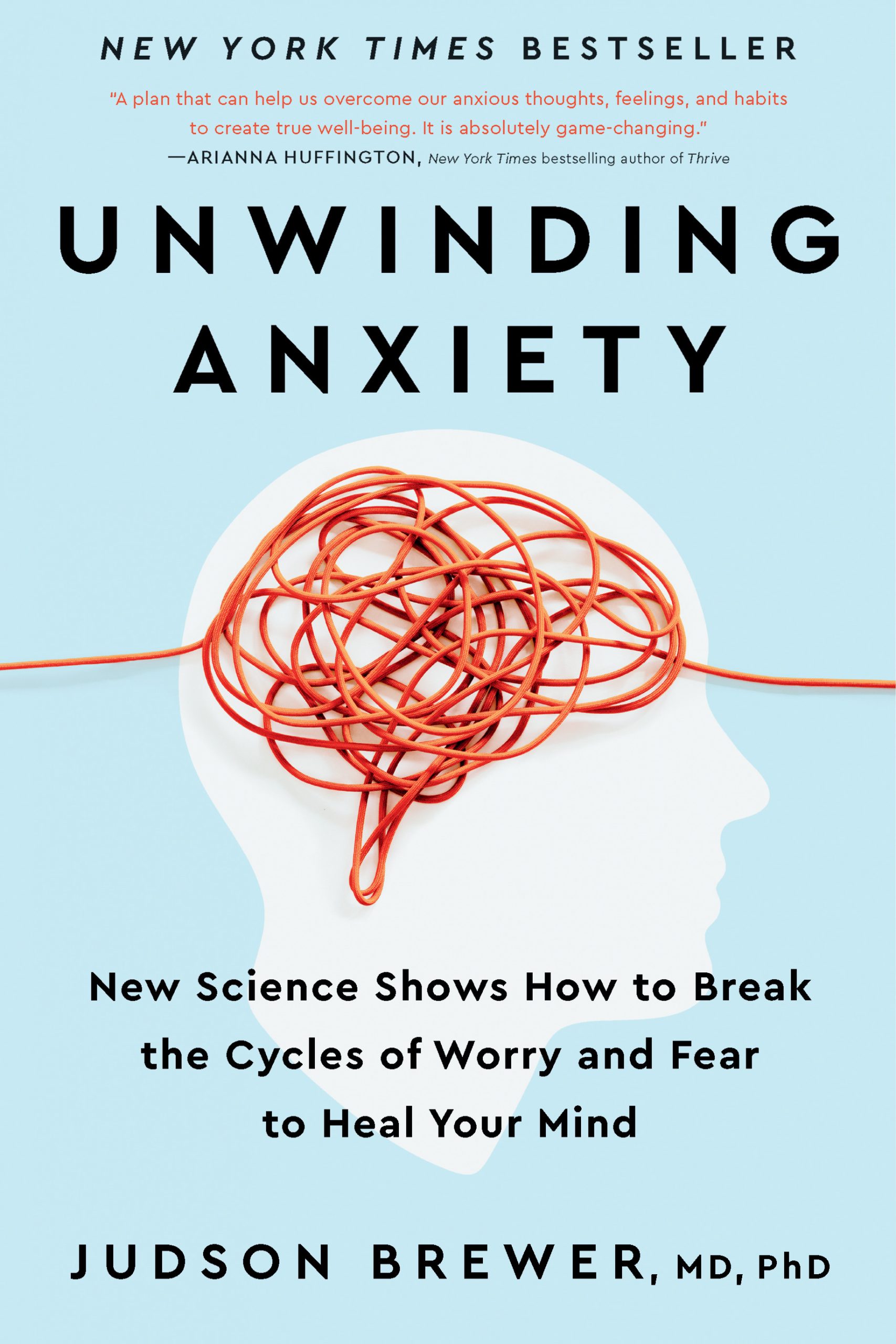

Unwinding anxiety
A clinically proven step-by-step plan to break the cycle of worry and fear that drives anxiety and addictive habits.
“Excepteur sint occaecat cupidatat non proident, sunt in culpa qui officia deserunt mollit anim id est laborum”.
Jon Kabat-Zinn - Founder of Mindfulness-Based Stress Reduction
We are living through one of the most anxious periods any of us can remember. Whether facing issues as public as a pandemic or as personal as having kids at home and fighting the urge to reach for the wine bottle every night, we are feeling overwhelmed and out of control. But in this timely book, Dr. Jud Brewer explains how to uproot anxiety at its source using brain-based techniques and small hacks accessible to anyone.
About the Book
We think of anxiety as everything from mild unease to full-blown panic.
But it’s also what drives the addictive behaviors and bad habits we use to cope (e.g. stress eating, procrastination, doom scrolling and social media). Plus, anxiety lives in a part of the brain that resists rational thought. So we get stuck in anxiety habit loops that we can’t think our way out of or use willpower to overcome.
Dr. Brewer teaches us map our brains to discover our triggers, defuse them with the simple but powerful practice of curiosity, and to train our brains using mindfulness and other practices that his lab has proven can work.
Distilling more than 20 years of research and hands-on work with thousands of patients, including Olympic athletes and coaches, and leaders in government and business, Dr. Brewer has created a clear, solution-oriented program that anyone can use to feel better — no matter how anxious they feel.
Key Takeaways
Willpower is weaker than you think: you cannot think your way out of anxiety.
Our brains have tricked us into thinking that we need to be anxious to get things done and perform well. Anxiety doesn’t actually improve performance.
Fear + Uncertainty = Anxiety. This is our brain’s survival system trying to help, but getting lost in today’s world.
Anxiety is a habit loop. Anxiety and worry feed on each other, getting us stuck, and making both worse.
Anxiety hides in unhealthy habits (e.g. stress eating, procrastination, distraction with social media)
The key component in the process of unwinding anxiety is learning to be curious.
You do need to learn how to be mindful and aware, but you don’t have to learn to meditate. Curiosity is a natural way into being mindfully aware.
You have to know how your mind works, before you can work with it
You can hack your brain’s reward system to overcome anxiety (and other unhealthy habits)

The Unwinding Anxiety book walks you through the same process and explains the underlying science used in the award-winning, evidence-based Unwinding Anxiety app .
57% reduction in anxiety
Health Value Award Winner 2019 & 2020

Hundreds of 5 star reviews in the App store
About Dr. Jud
Dr. Jud Brewer has spent over 20 years at Yale, MIT and Brown University researching how our brains form negative behavior patterns, bad habits and addictions, and the specific techniques needed to create lasting change.
Dr. Jud has worked with everyone from Olympic athletes to corporate leaders and been featured on 60 Minutes, the Washington Post, Time Magazine, and the BBC, among others. Learn more about Dr. Jud here .

Pin It on Pinterest

Unwinding Anxiety by Judson Brewer: A Review Of Judson Brewer’s Book

Anxiety disorders are on the rise globally, with an estimated 284 million people affected. While many try to “talk themselves down” from anxiety or panic attacks, these efforts rarely work long-term, and this is what Judson Brewer’s book comes to address. That’s because anxiety is a habit wired into our brains. Thankfully, Judson Brewer, a psychiatry and neuroscience expert, provides a science-backed approach to unwinding anxiety in his acclaimed book “ Unwinding Anxiety “.
UNDERSTANDING JUDSON BREWER’S EXPERTISE AND NEW BOOK ON ANXIETY
Judson Brewer, MD, PhD , is a thought leader in habit change and the mechanisms underlying addiction. He combines his expertise in psychiatry with decades of meditation practice. Brewer is the Director of Research and Innovation at Brown University’s Mindfulness Center and associate professor in its medical school.
Thanks for reading DrAiMD’s Substack! Subscribe for free to receive new posts and support my work.
Brewer has given popular TED talks on mindfulness and breaking bad habits, which have been viewed over 6 million times. He’s known for his pioneering research using mindfulness training to help people overcome addictions.
His book “Unwinding Anxiety” applies Brewer’s scientific insights about habits and the brain to address the rising anxiety epidemic. Released in 2022, this book provides readers with a practical, evidence-based approach to managing anxiety based on Brewer’s clinical experience and neuroscience research.

Unwinding Anxiety by Judson Brewer applies new scientific findings about anxiety to provide practical tools for overcoming it.
UNWINDING ANXIETY: A PROVEN APPROACH TO BREAKING FREE FROM ANXIETY
The core premise of “Unwinding Anxiety” is that anxiety is a habit wired in our brains. Like any habit, anxiety manifests through trigger-behavior-reward loops. The book introduces techniques to disrupt these anxiety loops and “unwind” anxiety.
Brewer explains how anxiety arises from unconscious evolutionary instincts related to survival. While our rational minds know there’s no real threat, ancient fear circuits still get activated and drive anxious thinking.
Importantly, the book delimits strategies that don’t work for anxiety, like venting emotions or endless rumination. Brewer then outlines his tested approach:
Recognize anxiety as a habit
Map out your personal anxiety triggers and responses
Use mindfulness to disrupt associated reward circuits
Create space for new, healthy habits to form
By seeing anxiety as a habit we’ve unconsciously cultivated, we gain power over it. Brewer provides tips to identify anxiety loops so we can respond differently.
A WEALTH OF SCIENCE-BACKED TOOLS TO REWIRE YOUR BRAIN
A huge draw of Brewer’s anxiety book is how he breaks down complex neuroscience in a relatable way. He helps readers understand anxiety-related brain functions, like the prefrontal cortex and amygdala.
The book contains powerful metaphors, like picturing your brain as a house share between “upstairs” and “downstairs” roommates. The upstairs prefrontal cortex tries to keep things orderly, while the reactive downstairs amygdala causes anxiety chaos.
Beyond explaining the science, Brewer equips readers with evidence-based tools to short-circuit anxious impulses and establish healthier habits. These include:
Urge surfing: Mindfully observing anxious thoughts without getting carried away by them.
RAIN : A mindfulness exercise to Recognize, Allow, Investigate, and Note anxiety.
Curiosity : Generating interest in anxiety sensations vs. reacting with frustration.
Self-compassion: Responding to anxiety with understanding, not judgment.
Brewer also shares relatable personal stories of clients learning to implement these techniques to manage anxiety symptoms. The book concludes with guidance on creating long-term lifestyle changes so anxiety gains less habitual power.
NOTABLE EXCERPTS FROM JUDSON BREWER’S UNWINDING ANXIETY
Here are some standout quotes and passages from “Unwinding Anxiety” that capture Brewer’s engaging writing style and ability to demystify anxiety:
“Trying to talk yourself out of being anxious or worrying is about as effective as trying to talk yourself out of being hungry when you see a pizza.”
This analogy highlights the futility of logic alone in calming anxiety. Brewer emphasizes addressing the root habits.
“It’s not the situation that triggers anxiety; it’s your relationship to the situation that does.”
Brewer advocates observing anxiety triggers mindfully without instantly reacting. Our response matters more than the trigger itself.
“You can’t stop anxiety if you don’t first know it’s there. It’s like trying to catch a ninja when the lights are off.”
We must cultivate mindfulness to recognize anxiety arising before habitual responses take over.
“Compassion greases the wheels of change by overriding the brakes our inner critics want to apply.”
Self-judgment makes anxiety worse. Treating ourselves with care enables growth.
Eustea Reads
A life in books and tea, book review: unwinding anxiety by judson alyn brewer.
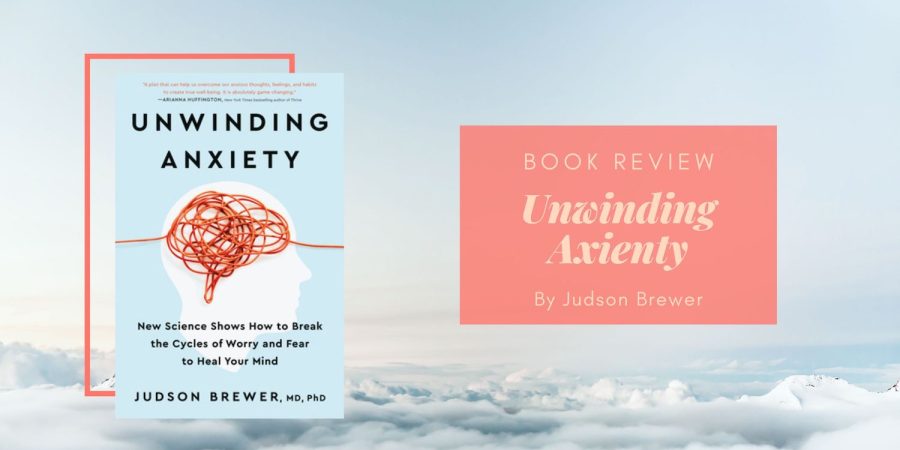
I saw a recommendation for this book and as a fairly anxious person, I thought it would be helpful. And wow, it has taken me so long to write this review, not because I was procrastinating, but essentially because I read the book twice – once where I read the book (where I made a lot of highlights) and another to actually take notes.
Unwinding Anxiety looks at anxiety as a habit loop. Our brain responds to triggers with behaviours that have rewards, and since we prefer familiar states, we can end up creating a habit of anxiety. Or really, a bad habit for anything, as the book rather ominously puts it:
“By combining the reward-based learning built into our old brain with intermitten reinforcement and immediate availability, we’ve created a dangerous formula for modern-day habits and addictions that goes well beyond what we typically think of as substance abuse.”
So how do we break this habit of anxiety (or smoking, or binge-eating, etc)? Well, Brewer proposes three steps, or three “gears” as he calls it:
- Gear One: Map out your anxiety habits using the Trigger-Behaviour-Reward model.
- Gear Two: Pay attention to the habit loop – is it as rewarding as it once was?
- Gear Three: Replace the habit loop with a bigger, better offer that is NOT a substitution. Brewer recommends mindfulness
The book goes into a lot of detail on how to practice these three gears. And even though he says that you shouldn’t be going from Gear One to Gear Three immediately, I thought that they seem to flow together pretty seamlessly. If you can notice a habit loop, you can slow down and feel its effects on your body. If you can feel what is going on and name it, you can practice curiosity about it and hopefully be a bit kinder to yourself about what you’re going through.
And yes, I have been trying to practice this. The good thing about this book is that Gear One is very easy to put into practice – there is no “ask” for you to take new action or to stop doing something. Just learn to observe yourself. Brewer recommends staying in Gear One as long as you need, so you can really just practice this until you are ready for step two or three.
What I really liked about this book is that it goes beyond anxiety. You could probably apply this advice to any bad habit you want to break, though I’m not sure how it can help in forming good habits like exercising or sleeping earlier. Still, I’m probably full of bad habits that can be stopped and I think just being able to change that aspect will have a significant impact.
Generally, I found the book easy to read. Because I felt all three gears were very similar, parts of the book could feel very repetitive. However, when I read that Brewer wrote this because he received feedback that his earlier book wasn’t actionable enough, I understood why he went into so much detail and kept restating things. The point of this book is to get you to put his three gears into action! If you just want the theory, you could probably just read the first part and selected chapters from each of the remaining sections. Or you could read his other book, though I’ve not read that and can’t say how similar it is.
Overall, I thought this was a great book! I don’t think it’s for people suffering from severe anxiety or severe depression, because those can be from chemical imbalances in the brain and you probably can’t think your way out of it, but most of us will probably be at least slightly anxious or stressed most of the time and I think the strategies mentioned here can be really helpful for that.
Featured Image: Photo from Canva
Share this:
- Click to share on Twitter (Opens in new window)
- Click to share on Facebook (Opens in new window)
4 thoughts on “ Book Review: Unwinding Anxiety by Judson Alyn Brewer ”
It does sound like a very practical and helpful book. The breakdown into three gears is interesting and definitely something worth testing out. Great review, Eustacia!
I liked that this book has things that you could put into practice straightaway. He mentions his apps a lot, but you could definitely practice the three gears without it!
I think it’s really great that these strategies are easy to follow and can be applied more widely. This sounds vaguely like CBT, which I like, so I might check this out. Great review!
If you read this, I hope you find it helpful too!
What do you think? Cancel reply

- Health, Fitness & Dieting
- Mental Health

Buy new: .savingPriceOverride { color:#CC0C39!important; font-weight: 300!important; } .reinventMobileHeaderPrice { font-weight: 400; } #apex_offerDisplay_mobile_feature_div .reinventPriceSavingsPercentageMargin, #apex_offerDisplay_mobile_feature_div .reinventPricePriceToPayMargin { margin-right: 4px; } -9% $32.85 $ 32 . 85 FREE delivery Saturday, June 8 on your first order Ships from: Amazon Sold by: AV02 Store
Save with used - like new .savingpriceoverride { color:#cc0c39important; font-weight: 300important; } .reinventmobileheaderprice { font-weight: 400; } #apex_offerdisplay_mobile_feature_div .reinventpricesavingspercentagemargin, #apex_offerdisplay_mobile_feature_div .reinventpricepricetopaymargin { margin-right: 4px; } $17.89 $ 17 . 89 free delivery saturday, june 8 on your first order ships from: amazon sold by: canada's best books.

Download the free Kindle app and start reading Kindle books instantly on your smartphone, tablet or computer – no Kindle device required .
Read instantly on your browser with Kindle for Web.
Using your mobile phone camera, scan the code below and download the Kindle app.

Image Unavailable

- To view this video, download Flash Player
Follow the author

Unwinding Anxiety: New Science Shows How to Break the Cycles of Worry and Fear to Heal Your Mind Hardcover – March 9 2021
Purchase options and add-ons.
- Print length 304 pages
- Language English
- Publisher Avery
- Publication date March 9 2021
- Dimensions 16 x 2.67 x 23.62 cm
- ISBN-10 0593330447
- ISBN-13 978-0593330449
- See all details
Frequently bought together

What other items do customers buy after viewing this item?

From the Publisher

Product description
About the author, excerpt. © reprinted by permission. all rights reserved..
In psychology, the spread of emotion from one person to another is aptly termed social contagion. Our own anxiety can be cued/triggered simply by talking to someone else who is anxious. Their fearful words are like a sneeze landing directly on our brain, emotionally infecting our PFC, and sending it out of control as we begin to worry about everything from whether our family members will get sick to how our jobs will be affected. When we can’t control our anxiety, that emotional fever spikes into panic (defined online as “sudden uncontrollable fear or anxiety, often causing wildly unthinking behavior”). Overwhelmed by uncertainty and fear of the future, our PFCs—the rational thinking parts of our brains—go off-line. Logically, we know that we don’t need to store a six-month supply of toilet paper in our basement, but when we’re running through the grocery store and see someone’s cart piled high with Charmin, their anxiety infects us, and we go into survival mode. Must. Get. Toilet. Paper. Our PFC comes back online only when we’re out in the parking lot trying to figure out how to fit all that toilet paper into our car or carry it onto the subway. So how do we keep our PFCs online in uncertain times? How can we avoid panic? Too many times, I’ve seen my anxious clinic patients try to suppress or think themselves out of anxiety. Unfortunately, both willpower and reasoning rely on the PFC, which at these critical moments has shut down and isn’t available. Instead, I start by teaching them how their brains work so that they can understand how uncertainty weakens their brain’s ability to deal with stress, priming it for anxiety when fear hits. Learning that uncertainty triggers anxiety, which in turn can lead to panic, allows them to be on the lookout. And simply knowing that this is their survival brain kicking into high gear (even if it is a little misguided because it doesn’t have enough information) helps put my patients a little more at ease. But this is only the first step. Our brains are constantly asking “what if?” When we log on to social media and scroll for the latest information, all we see is more speculation and fear. Social contagion knows no physical boundaries and can be spread from anywhere in the world. Instead of desperately searching for information, we need to add something more reliable to help us work with our emotions. Ironically, the antidote to panic relies on our survival instincts—leveraging these same learning mechanisms that lead to worry and anxiety in the first place. To hack our brains and break the anxiety cycle, we must become aware of two things: that we are getting anxious and/or panicking and what results from anxiety/panicking. This helps us see if our behavior is actually helping us survive or in fact is moving us in the opposite direction. Panic can lead to impulsive behaviors that are dangerous; anxiety weakens us mentally and physically and also has more long-term health consequences. Becoming aware of these damaging effects helps our brain’s learning system determine the relative worth of behaviors: more valuable (rewarding) behaviors are placed higher in a reward hierarchy in our brain, and thus are more likely to be repeated in the future, while the less valuable (unrewarding) behaviors fall to the bottom. Once we are aware of how unrewarding anxiety is, we can then bring in the bigger, better offer, or BBO. Since our brains will choose more rewarding behaviors simply because they feel better, we can practice replacing old habitual behaviors such as worry with those that are naturally more rewarding. For example, early on in the COVID‑19 pandemic, public health officials warned us to stop touching our faces, because we can more easily catch a virus if we’ve touched a doorknob or contaminated surface and then touch our face. If you notice that you have a habit of touching your face (which many of us do: one study published back in 2015 found that we do this, on average, twenty-six times an hour), you can be on the lookout for when you carry out that behavior. With that trigger, you can step back and notice if you are starting to worry as a mental behavior (“oh no, I touched my face—maybe I’ll get sick!”). Instead of panicking, you can take a deep breath and ask yourself, “When was the last time I washed my hands?” Just by taking a moment to pause and ask such a question, you give your PFC a chance to come back online and do what it does best: think (“oh, right! I just washed my hands”). Here you can leverage certainty: if you’ve just washed your hands, haven’t been in public, and so forth, the likelihood that you’re going to get sick is pretty low. Understanding these simple learning mechanisms will help you “keep calm and carry on” (which is how Londoners dealt with the uncertainty of constant air raids in World War II) instead of getting caught in anxiety or panic in the face of uncertainty. At times when your mind starts to spin out in your worry du jour, you can pause and take a deep breath while you wait for your PFC to come back online. Once it’s up and running again, you can then compare the feeling of anxiety to that of calmness and think clearly. To our brains, it’s a no‑brainer. More important, once you are able to tap into your brain’s power to overcome anxiety, you can broaden your learning to work with other habitual tendencies as well. It simply takes a little practice so that the bigger, better offers become new habits not just for anxiety, but far beyond.
Product details
- Publisher : Avery (March 9 2021)
- Language : English
- Hardcover : 304 pages
- ISBN-10 : 0593330447
- ISBN-13 : 978-0593330449
- Item weight : 481 g
- Dimensions : 16 x 2.67 x 23.62 cm
- #75 in Self-Help for Anxieties & Phobias
- #78 in Psychopathologies (Books)
- #84 in Anxiety Disorders
About the author
Judson brewer.
Jud Brewer MD PhD is a thought leader in the field of habit change and the “science of self-mastery”, having combined over 20 years of experience with mindfulness training with his scientific research therein. He is the Director of Research and Innovation at the Mindfulness Center and associate professor in Behavioral and Social Sciences and Psychiatry at the Schools of Public Health & Medicine at Brown University. He also is a research affiliate at MIT. A psychiatrist and internationally known expert in mindfulness training for addictions, Brewer has developed and tested novel mindfulness programs for habit change, including both in-person and app-based treatments for smoking, emotional eating, and anxiety. He has also studied the underlying neural mechanisms of mindfulness using standard and real-time fMRI and EEG neurofeedback. He has trained US Olympic athletes and coaches, foreign government ministers, and his work has been featured on 60 Minutes, TED (4th most viewed talk of 2016, with 14+ Million views), Time magazine (top 100 new health discoveries of 2013), Forbes, BBC, NPR, Al Jazeera (documentary about his research), Businessweek and others. His work has been funded by the National Institutes of Health, American Heart Association, among others. Dr. Brewer founded MindSciences to move his discoveries of clinical evidence behind mindfulness for anxiety, eating, smoking and other behavior change into the hands of consumers (see www.drjud.com for more information). He is the author of The Craving Mind: from cigarettes to smartphones to love, why we get hooked and how we can break bad habits (New Haven: Yale University Press, 2017). Follow him on twitter @judbrewer.
Customer reviews
Reviews with images.

- Sort reviews by Top reviews Most recent Top reviews
Top reviews from Canada
There was a problem filtering reviews right now. please try again later..
Top reviews from other countries
- Amazon and Our Planet
- Investor Relations
- Press Releases
- Amazon Science
- Sell on Amazon
- Supply to Amazon
- Become an Affiliate
- Protect & Build Your Brand
- Sell on Amazon Handmade
- Advertise Your Products
- Independently Publish with Us
- Host an Amazon Hub
- Amazon.ca Rewards Mastercard
- Shop with Points
- Reload Your Balance
- Amazon Currency Converter
- Amazon Cash
- Shipping Rates & Policies
- Amazon Prime
- Returns Are Easy
- Manage your Content and Devices
- Recalls and Product Safety Alerts
- Customer Service
- Conditions of Use
- Privacy Notice
- Interest-Based Ads
- Amazon.com.ca ULC | 40 King Street W 47th Floor, Toronto, Ontario, Canada, M5H 3Y2 |1-877-586-3230
Moore Balanced
Balancing food, fitness, and well-being
Review: Unwinding Anxiety by Judson Brewer

In my quest to relieve my anxiety and stress, I stumbled across Unwinding Anxiety by Judson Brewer .
This is a good book for those who are looking to break the cycle of anxiety, but also for anyone who is looking to change their habits or lifestyle. Because anxiety results in a lot of ingrained habits that, while they may have provided some relief at one point, are detrimental to our wellbeing, this book focuses a lot on ways to successfully change habits.
Dr. Brewer walks you through how to use mindfulness to recognize your anxiety triggers and your reaction. This isn’t a meditation-heavy book, although he does describe the benefits of meditation and his experience with it. Rather, he encourages you to be mindful of what you’re doing: think about things you have done before and be aware of what you’re doing in your day to day life so you can recognize when you’re doing them in real time. So often we do things mindlessly, and when we are in auto-pilot, we aren’t able to change our bad habits that are actually reinforcing our anxiety.
Table of Contents
Details About “Unwinding Anxiety”
The book is in 3 parts. The first part deals more directly with anxiety itself. He has an activity to list out your triggers, the behavior you default to, and the result. It seems like a simple exercise, but I did have trouble with this. I couldn’t think of many when I initially did it. I believe he does say that it’s an exercise to continue doing, and as the days went on, I added more to my table. Here are a few examples of mine:
Parts two and three focus more on habit change. We’ve all built habits that are no longer serving us and, in many cases, make our anxiety worse. Dr. Brewer goes through the science of how habits are formed, which helps explain why his methods will work. Part two goes into how your brain constantly reassesses what value each action does, and how you can use this to break your habits. When you are mindful of what you are doing, you can be aware of what the real consequences of your bad habits are. Your brain will update its reward value.
In part three, he focuses on strategies to change your behavior. While many popular strategies focus on habit replacement (ex., eating candy instead of smoking a cigarette), Dr. Brewer does not recommend that. Replacing one habit for another oftentimes has the same result as the old habit. Instead, he encourages curiosity, which you can read about on his blog . He also provides methods to aid your mindfulness, including the RAIN method ( Tara Brach has done a lot of work on expanding this ) and Loving Kindness mediation.
Favorite Parts
Quote from someone else.
At one point, the author quotes Ijeoma Umebinyuo’s Three Routes to Healing:
- You must let the pain visit
- You must allow it to teach you
- You must not allow it to overstay
All three of these steps are equally important. I think they distill the healing process very well.
Anxiety as a comfort
There was one sentence that really stuck out to me. Dr. Brewer was describing a patient and said
Because of its familiarity, anxiety had strangely become a comfort to him, yet he had outgrown it now.
I felt this deeply, because it’s where I am. Anxiety and stress have become my safe and familiar place, but they are no longer serving me.
When not to use substitutions for bad habits
As I mentioned, the author doesn’t like substituting new habits for old; he wants to break the habit loop altogether. When evaluating whether your substitutions feed the habit loop, ask yourself if they result in restlessness, contraction, temporary fixes, or a desire for more. These are all signs of habituation.
Overall: Recommended
I bought the audiobook version , and enjoyed the narrator. With books like these, you don’t really want to notice the narrator, and I didn’t. He had a calm voice, spoke clearly at an even pace, and didn’t do any weird voices.
If you’re on the fence, check out the author’s TEDMED talk. If you found it interesting, I would recommend the book Unwinding Anxiety .
Leave a Reply Cancel reply
This site uses Akismet to reduce spam. Learn how your comment data is processed .
Book review: Unwinding Anxiety by Judson Brewer

I am not an anxious person but, like most writers, I do suffer from procrastination. The empty page and the blank screen can too often be a cue to do that long-delayed DIY task rather being a signal that it’s time to actually write the story that’s been buzzing around at the back of my mind.
So I’m pleased to say that there was a lot in this book about overcoming procrastination, which is a facet of anxiety, as well as much on actual anxiety. And, when I want it to be, it’s actually quite effective – it’s all to do with stopping the feedback loops that allow you to focus on immediate relief of mild anxiety rather than the far greater, but somewhat delayed, relief that comes from what you actually need to do.
Brewer is also rather good on the evolutionary origins of these anxiety feedback loops and how they have deep roots in our basic brain biology. So, overall, an interesting and helpful book.
Leave a Reply
Click here to cancel reply.
XHTML: You can use these tags: <a href="" title=""> <abbr title=""> <acronym title=""> <b> <blockquote cite=""> <cite> <code> <del datetime=""> <em> <i> <q cite=""> <s> <strike> <strong>
- Share full article
Advertisement
That Anxiety You’re Feeling? It’s a Habit You Can Unlearn.
An addiction psychiatrist’s counterintuitive approach to dealing with worry, craving and anxiety..
[MUSIC PLAYING]
I’m Ezra Klein and this is “The Ezra Klein Show.” [MUSIC PLAYING]
I am an anxious person I come from a family of anxious people. And I’m going to be honest, it sucks. There is this line from the book, “The Way to Love,” by the Jesuit priest Anthony de Mello. Great, great book, by the way. I don’t talk that much about it, but it’s one of my favorites. But it describes my experience of this so perfectly. He’s not talking about anxiety. He’s talking about the way human beings experience life, but he writes, quote, “Think of yourself in a concert hall listening to the strains of the sweetest music when you suddenly remember that you forgot to lock your car. You’re anxious about the car. You cannot walk out of the hall and you cannot enjoy the music.” End quote. That is often how life feels to me. Things are objectively amazing. I live in an age of antibiotics, and vaccines, and YouTube, and the Marvel cinematic universe, and the internet. And I have a family I love, and a job I love, and I’m healthy and I’m privileged in a million ways. And I’m still just spinning my mental wheels, endlessly ruminating on things I don’t want to be thinking about. I pride myself on my own discipline and my own mind is so out of control. So then in addition to whatever it is I’m worried about, I’m also meta-pissed off at myself for that worrying. Why can’t I just focus on what I know I should be focusing on? I don’t say any of this for sympathy. I say it because I know I’m not alone in it. Every time I mention anxiety on the show, I get emails from you all about your experiences with it, about how it feels. And obviously this has been a year that has supercharged anxious tendencies for a lot of us. The actual situation has been, and frankly, still is, terrifying. And then we’re trapped inside with nothing to do about it. It’s the worst possible mix. So I’ve been wanting to do a show on anxiety for a while, but I wasn’t sure who to do it with. And then Jud Brewer released his book, “Unwinding Anxiety.” Brewer is at Brown University, where he’s a director of research and innovation at the Mindfulness Center and he’s an associate professor in psychiatry. But I followed his work for a while, both because of the studies he’s done around meditation and the minds of master meditators, but also because of his previous book, which is called “The Craving Mind,” which I found to be one of the best things I’ve read, at least on addiction. But here he extends that framework and argues that anxiety is a kind of addiction, and that like any addiction you have to understand its rewards in order to begin addressing it. I think it’s a pretty interesting framework. I’m not saying it has cured me of anxiety, but it’s given me a much more generative way to think about it and to approach it. And so I asked him on the show. As always, my email is [email protected]. Please send me your guest suggestions. Here is Dr. Jud Brewer.
The core of your book is this idea that anxiety is a learned habit. So what is a habit?
Well, if you think of a habit as needing three essential elements, it’s a trigger, a behavior, and a result. And if you think of this from a basic survival brain perspective, our ancient ancestors needed to remember two main things, like where to find food and how to avoid danger. So if they saw food — they’re out foraging for food, they saw food. There’s the trigger. They would eat the food. There’s the behavior. And then their stomach would send this dopamine signal to their brain that was the reward. And it basically said, remember what you ate and where you found it. Same is true for a danger. You see the danger. You run away and your reward is that you don’t get eaten.
So why is anxiety, then, a habit?
If you look at anxiety, the definition of this feeling of nervousness, or worry, or unease about an imminent event or something with an uncertain outcome, that worry can actually be a mental behavior. So we can have a feeling of anxiety and then that can trigger the mental behavior of worrying. And as we start worrying, that actually gets reinforced in our brain because it makes us feel like we’re in control or at least it makes it feel like we’re doing something.
I do want to hold onto this idea of how we learn this, because so much of the book is about reward-based learning and the power of that. But it’s really counter-intuitive what you’re saying. Because if I run away and the reward is I don’t get eaten, great, I get why that feels like a reward. If I eat a cookie and the reward is I got to eat a cookie, I get why that feels like a reward.
I am anxious a lot. I am anxious this morning. It’s a great day to talk to you. [LAUGHTER] It does not feel like a reward. It does not feel good. I don’t enjoy it. I yell at myself in my own head about it. So when you say that I’m learning this through some kind of dopamine signal, how?
Yeah, there can be a couple of elements here. One is our brain goes into problem-solving mode. So if you think about our old brain, the survival brain that we talked about — the trigger behavior, reward — layered on top of it more recently is the new brain, literally called the neocortex. And it helps us survive in a slightly different way, which is through thinking and planning. So think of your cookie. When if you’re hungry, your stomach starts rumbling and you go get a cookie from the kitchen or something like that. If we don’t have information, our neocortex starts rumbling and says, go get information. So there’s that survival signal that says, hey, there’s some uncertainty here. Let’s make this more certain. Let’s go get information to do that. And when we get information, we get this reward. Oh, I figured something out or I now know something. And that piece is actually helpful for survival. The problem is when we don’t find a solution, our brain just starts worrying and worrying, spinning out of control, like what if this, what if that, what if this, what if that. So it’s kind of this survival mechanism that gets tweaked a little bit when we don’t have information. Does that make more sense?
It does in a slightly unnerving way to me. So — [LAUGHTER] — and I’m just going to use myself liberally in this conversation. But I always think of one of my great attributes as a person is being my problem-solving capability. Very, very good at finding problems. Very good at coming up with solutions to them. Very good at implementing those solutions. And so what you’re saying is that the piece of me that has learned that that is a core driver and a core way I move through the world is also the piece of me that is driving the unproductive turning over in my head things that I can’t solve.
Yes, absolutely. So think of it as a double-edged sword. So it can help us survive through that planning mode. But when we don’t have information and we keep revving it — or maybe the apt analogy would be an engine. We’re driving forward and if we put the clutch in and the engine — we just keep slamming our foot on the gas, that engine is going to rev and burn itself out. That’s what worry is. It’s our mind revving and revving and revving and saying, well, what if this, what if that, what if this. The irony there is it actually makes it harder for us to think and plan.
So we’ve talked about anxiety as being a product of reward-based learning. And so quite a bit of the book is about trying to untangle what you have actually learned and how you keep learning it. Can you talk about habit loops?
I’d be happy to. And here I think of it as if we don’t know how our minds work, we’re not going to be able to work with them. Maybe I can give an example. I write about one of my patients from my clinic in the book who was referred to me for anxiety. And I could tell he was anxious right when he walked in the door, so that was pretty clear. But when I started taking his history, we started talking about how he had developed panic attacks around driving. So he’d be on the highway driving and he felt like — he described it as I feel like I’m in a speeding bullet. And as he would drive and get those thoughts, he would start to panic. And then that led to panic attacks and he started avoiding driving on the highway. So I just pulled out a piece of paper and on my desk wrote out trigger, behavior, reward. And I said, OK, let me see if I’m understanding what you’re describing. Is the trigger these thoughts? Is the behavior avoiding driving on the highway? And is the result or the reward you not having those panic attacks? And he said, yes. And he had this aha moment where he started to see how that was feeding back and leading him to have full blown panic disorder. He had never recognized that before. He hadn’t seen how his mind worked. So here I think of it as the first step is just mapping out these habit loops. If we can become aware of how we’re being driven by these things, whether it’s anxiety, procrastination, or any other habit, that’s the first step in being able to work with it.
This is such an important part of the book. I actually want to try to model it a little bit. So let’s say I was coming to your class or I was in your clinic. How would you help me map out my habit loops? Let’s do it live.
So one thing I would say is, hey, we have a free habit mapper. Go to mapmyhabit.com and download this PDF. And so you download it and there would be this circle with three boxes that are interconnected. So I would say, OK, Ezra, well, what’s the behavior? Is it worrying? Is it procrastinating? What’s the behavior? Let’s start there.
Worrying, fretting, ruminating, turning around one thought over and over in my mind.
So the behavior is worry. If you trace it back, are there specific things that trigger you to worry?
Yeah, there are certain things that have long stuck in my head. There are things from the past or there are particular worries I have about the future. That if I get caught on one of them or triggered on one of them, if something brings it back to mind, it’s like it’s a more magnetic thought for me. Other thoughts I pick up and I put down. And these, if they get in there, they stick like it’s on flypaper.
That’s a really nice image. They’re magnetic. The closer they get, the —
— the harder it is to get away from them. And I like how you say sometimes, because the trigger is actually the least important part of the equation. And the reason I say that is triggers don’t actually drive future behavior. They just trigger it. It’s actually the behavior and then how rewarding that behavior is. So if we’d finished out the mapping, so you might be triggered by certain thoughts, these magnetic thoughts, in particular, the behavior is to worry. And then I would ask you, well, what’s the result of worrying? How does it feel in your body when you worry?
So this is the part I had the most trouble with in the book. It feels bad.
It feels bad all the time. And not only does it feel bad — I mean, you’ve done a tremendous work on meditation. I’ve had a mindfulness practice for a long time now. I know it feels bad. I watch it. I do meditation, in part, to try to deal with this. I yell at myself in my own head. I’m like — the stop — just like stop that. It does not feel good.
And that’s why it’s hard for me to imagine it’s a reward-based learning system, because I feel like I’m constantly punishing myself. And not only that, but I have the frame around it that it’s a kind of constant self-castigation.
Yeah. Let’s geek out about this a little bit, because I think that’ll help explain what you’re talking about. So there are two elements here that can be happening in terms of how worry gets formed as a habit. So one is it feels better to worry than not to worry. So if you think of maybe a parent of a teenager who just gets their driver’s license. And the kid goes out to party with their friends on a Friday night. The parent stays up worrying, oh, is my kid going to be OK, until they hear the door knob open or the garage door open and they know, OK, my child is home safely. Now, I can promise you that that worrying did not keep their child safe, yet it feels better than not doing anything. So our brain says, ooh, this is bad, do something, do something. And the worrying is doing and it feels better than not doing. So there’s one piece. The other piece is if it’s a problem that we’re worrying about. Occasionally, we’ll come up with a solution and then we’ll ascribe the worrying with coming up with a solution, which is likely not the case because worrying makes it harder to think. It makes it harder for us to be in our growth mindset where we can really see lots of possibilities. But just the fact that the two happen at the same time, our brains love to make causal connections where they say, oh, I was worrying — true — and I came up with a solution — true — so therefore, the worrying must have helped me come up with the solution.
Well, that’s the place where I saw it in myself in the book, that I do a lot of planning when I worry. And the plans often don’t work, but it does seem to me at least that something I’ve learned is a tremendous amount of fret, plan, act. And I feel in the moment If I’m able with that concern to come up with a theory of what I’m going to do about it, then I feel the little reward of the anxiety going down. I feel a little bit of relief. And so in some ways, the rewarding behavior seems to me to be coming up with plans. They’re just not very good plans typically. And I think — like we’re in podcasting here. Podcasting loves nothing like it, loves productivity life hacks. And I love productivity life hacks. I love thinking about ways I could get up earlier and do more. And I do it. And sometimes it’s useful for me. But I do think that whole world a little bit builds this way. You have a problem. Here’s a quick plan. Here’s a plan. Here’s another plan. And even if the plans don’t work, or the diets don’t work, or whatever it is, that there is this intermediate thought step where it feels to your brain like it worked before anything has happened.
Yes, absolutely. And this is even — we see this with the placebo effect with medications. We’re like, oh, I’m taking a new medication and therefore I’m feeling better, even if it’s just a placebo effect. So that’s how our brains are set up. They’re set up to say, oh, here’s something new. I’m going to try it. And then it takes a while for that to tail off where that initial excitement was actually driving the effect more than whatever that life hack was itself.
But then here’s a question. As I understand the dopamine system, it’s a learning system. It’s a pretty complicated system, but it has to do with changing your expectations of the future as much as it does anything else. But it doesn’t explain why it prioritizes some things over others, why some thoughts are sticky for me, some worries are sticky for me. Why so much that is good in my life does not have the same magnetic pull? Why things that are more objectively important does not have the same magnetic pull? I mean, as you were saying, anxiety is frustrating because you’re not thinking clearly. And often my meta-frustration is that I know what is more important that I probably should be worrying about and I’m not. I’m on this little piddling argument from three years ago or something. So what is the theory of not just why we worry, but why we worry about such dumb things?
Well, it really depends on how rewarding they either are now or how rewarding they were when they first got set up. So our brain is really a set of this whole hierarchy of reward value in terms of different behaviors. And that can even apply to specific instances that we’ve had. So for example, if somebody did us wrong and we start ruminating about that and we’re like, oh, I can’t believe — I should have said this. There’s this self-righteous quality that has to do with our ego that is very rewarding to think about, oh, if I had only said this, or I can’t believe this person said this. So it’s not only the self-righteous piece, but also outrage. All of those actually can activate the same system where we get excited, we get outraged. And that actually can jack the dopamine system as well. So it becomes reinforcing in that respect. There’s actually a Burmese meditation teacher, Sayadaw U Pandita, who said, “We mistake excitement of the mind for happiness.” And so here that exciting quality, that’s indicating that dopamine is firing, generally speaking. And so there’s that exciting quality of life that we can actually get addicted to drama or excitement itself. And there can be that excitement in rehashing that argument that we had three years ago as compared to something that is more meaningful now, but doesn’t quite have that juice — that dopamine juice to it.
Why is the I so powerful here? One of the things I always notice about my own fretting is my job, my work, what I’ve devoted most of my waking hours to, is thinking about societal and global problems. I write about climate change. I write about health care policy. I write about the economy. I write about the coming of AI, and on and on and on. I have trouble focusing on those things in my head. I could do it externally, but I worry about me in my head. I worry about dumb stuff in my life. And that strikes me as true for a lot of the people I know. I don’t think it’s just my own experience.
It’s not just you. [LAUGHTER]
Yeah, so what is going on in the connections there that we worry so much more about small-bore individual things than large-scale societal things that really do affect us quite a bit and affect our children and the people we care about?
There’s a network of brain regions, actually called the default mode network, that has to do with self-referential processing. It’s called the default mode, because that’s what we default to when we’re not doing anything else. The sense of self is kind of a habit in the sense of this is just what I do. I think about myself. And it’s also helpful to be planning about our future. It’s not just planning about the future, but it’s helpful when we’re planning to think about us in the future. So we can see how that’s pragmatic. But also there was an interesting study that was published a couple of years ago where this group at UCLA looked at Instagram feeds from adolescents. And what they did was they just manipulated the number of likes some pictures got. So some pictures got a bunch and some pictures got a few. And what they found was that they were activating their reward system, but they were also activating — co-activating this default mode network. So there seems to be something inherently, quote unquote, “rewarding” about things related to us. So, ooh, I got a bunch of likes. There’s that excited quality that comes with that that activates this self-referential network. So it seems to be baked right into our brains.
There’s a study you reference in the book, “A Wandering Mind Is an Unhappy Mind.” Can you tell me a bit about that?
Yes, this is one of the first studies that I’m aware of that actually used smartphones. So this is back in 2010 when the iPhone was first being rolled out. And there was a couple of researchers at Harvard — I think it was Killingsworth and Gilbert — where they basically just pinged people on their phone and asked them about — basically, what are you doing and how happy are you? And what they found was that on average people’s minds were wandering to the past or the future — ready for this — 47 percent of waking life. [LAUGHS] I just want to let that settle in. Almost of 50 percent waking life we are not present. Wow.
That seems low to me. [LAUGHTER]
The next piece here is that on average they concluded when they asked people whether their mind was wandering, they actually were feeling worse than when they were present. So they concluded a wandering mind is an unhappy mind. That was their conclusion based on what they observed.
And to what extent is this wandering versus just functioning? Something weirdly that’s coming to my mind here is that there’s a famous podcast that Elon Musk did with Joe Rogan. And it’s famous because Elon Musk just smokes a joint in it and that became a whole thing. But there’s a pretty — I always thought a very telling moment in that conversation where Rogan says — and this is from my memory — but he’s basically like it seems great to be you. You make rocket ships. You make cars. You date beautiful women. You’re rich. And Musk, sounding really sad, just says, yeah, but if you were in my mind, you’d know — and again, I’m paraphrasing — you can’t turn it off. [LAUGHTER] He says this a couple of times. You can’t turn it off.
And here’s a real smart guy. Has a lot. Has done really, really well. And it struck me as his subjective experience of his own mind was a pretty tough one, which I think then suggests some other things in his behavior make a little bit more sense if you’re trying to distract from that. Is that right that the more we’re sitting in our minds, the more we’re at least at risk for some of these more frustrating moments?
Absolutely. And I think this reminds me of this great five-minute skit from Bob Newhart. Do you remember that was the comedian from the ‘70s? So he had this skit called “Just Stop It,” where a woman walks into the therapist’s office — and he’s the therapist — and basically says, I have this problem. And he basically leans over his desk and says, “Just stop it.” And they go back and forth for five minutes. There’s a relief on the Parthenon from ancient Greece where there’s this rider and the horse. And the rider is reason and willpower and the horse is passions. And so if you — I don’t presume to know exactly what’s going on in Elon Musk’s mind, but these thoughts are like these — are horse. And it’s just running. And we’re the rider. And if we try to stop it, it just doesn’t work. As much as it would be great if it did — it would be great — my patients walk into my office, and I say, “Just stop smoking. Just stop overeating. Just stop worrying.” It would be great. It could be one visit for every patient and we’d cure everyone.
Take another moment on that. You have a point in the book where you say that you believe willpower is functionally a myth. And that even if I don’t buy your argument that willpower is functionally a myth, it is definitely a myth in the times when you need it most. When you are most concerned, that’s when your willpower is going to be most absent. Why?
Yes. So the prefrontal cortex is the seat of cognitive control. It’s the seat of the proverbial willpower. And that’s the part of the brain — it’s the youngest and the weakest from an evolutionary perspective. It’s the first that goes offline when we get stressed or when we get anxious. I’m not sure we know exactly why it’s the first that goes offline, but there’s a lot of research suggests that that is the first that goes offline. And we probably know this from our own experience. My patients who struggle with addictions, for example, there’s this acronym HALT. When they’re hungry, angry, lonely or tired, that’s when they’re most likely or most vulnerable to relapse, because their thinking and planning brain is offline.
You have a line in the book. You write, “You can’t think your way out of a bad habit or into a good one. As much as we all have wishes and plans for our habits, our feeling body trumps our thinking mind.” Tell me about that.
Yes. So we like to think that our thinking mind is in control. But if you look at how behavior is driven, thinking really doesn’t hold a candle to the feeling body. The feeling body — those urges are much stronger. And in the same way we can’t stop our thoughts. I often get people coming to me in a seminar or if I’m teaching a class where they say, oh, how do I just turn off my mind? How do I just stop my thoughts? And the first thing I say to them is, well, good luck. Tell me if you can get that to work. Nobody’s ever come back and said, I figured out the thought switch and I’ve turned it off. The second thing is, well, I actually think thinking is helpful. Thinking and planning is helpful. But the third piece here is our brains are driven based on how rewarding something is. So if we can actually change our relationship to our thoughts, we can actually get in control. So I think we’ve been looking in this direction, whether it’s willpower or however you want to think of it — we’ve been looking in the wrong direction. It’s actually we should be looking in the neuroscience direction. How does our mind work? And if we can understand how our mind work, then we can actually hack it, if you want to put it in the life hack perspective.
I don’t. I want to — [LAUGHTER] — avoid that word for what you’re talking about. Very specifically I want to avoid that word. So let’s go through that then. So something triggers me. I worry and then I plan. And that feeling of planning gives me some sense of control that is some kind of reward. Now what?
I actually set up the book in three steps. So the first step is being able to map out these habit loops. So we just talked about that. And the second step is really understanding that our brains are set up based on how rewarding behaviors are. If a behavior is rewarding, we’re going to keep doing it. If it’s not rewarding, we’re going to stop. So actually let me use an analogy or an example from something else around habit change and then we’ll come back to the worrying piece, because I think this will help frame it. My lab just finished a study where we were looking at how to help people stop overeating. And so we had actually built this tool into this Eat Right Now app where we could measure reward value as somebody was going through the process of trying to stop overeating. And instead of telling them to stop overeating, what we had them do was bring awareness to the process of overeating itself. And we specifically had them really pay attention as they overate and also on the results of overeating. And it took only 10 to 15 times of somebody really paying attention as they overate to realize that overeating feels worse than not overeating and to actually shift the behavior. So we can apply that here to anxiety and to worry as well. The key aspect there is really paying attention to how rewarding the behavior is. You’ve already named it. You said, well, when I worry, it’s not that rewarding. Yeah, we’re doing it as a habit. So we really have to link up that cause and effect relationship, because that’s what changes reward value. And when that reward value changes, that’s when we change a behavior.
Let’s try to ground this. And I’ll, again, use myself as an example. I have a lot of trouble exercising control around a lot of food. Because I know my willpower will fail me, I don’t keep a lot of ready-to-eat food in my house. I have to cook almost everything that I would consume and that works for me. But I’ve known forever that if I’m out and people order pizza, I will have five or six slices and I will feel sick. And I actually to some degree avoid those events, because I know I will feel bad. So this has been many, many times this happened. I know I don’t enjoy it. I have watched the feeling in myself. I feel ill afterwards. I wake up the next morning and don’t feel good from how I slept. And it hasn’t really changed that drive where I’m sitting there at a table and 40 percent of my mind is on the fact that there’s still more pizza right there in front of me. So what went wrong for me? Why didn’t I change the reward?
So you can’t change the reward by avoiding the behavior. If I’m understanding what you’re saying, you try to avoid those situations or — well, let me ask you this. When you overate the pizza, were you paying attention as you were overeating?
I mean, probably not bite by bite as a meditation master might. But I’m attentive to the fact that there’s a cause and effect that feels bad in my body. It’s not that I mentally am mad at myself about pizza. And yet, I don’t really trust that if you put me back in that situation, I would do any better. [LAUGHS]
Yeah. So here, if you ever go back into the situation, one thing to play with — I actually have folks do this. I have them do it bite by bite. To just ask themselves, is this bite more rewarding than the last bite? So they can actually map out that pleasure plateau where they can see, oh, this is where it ends. And I’ve actually had a lot of people do it with New York pizza, because it tastes so good. And I would say on average, people report that it’s after about two slices that it really plateaus. And then that third slice and there on is bad news for them.
What is happening in the person when you do that? Because what you’re saying is you want to pay really close attention and at some point, through some kind of repetition, your brain’s sense of the reward of the behavior will change. But it will only change because you are giving it the somatic data, this felt sense data?
So that’s what I’m trying to get at here. What I’m saying to you in different ways is I’ve had a bunch of experiences where I think I fed my brain somatic data that this doesn’t feel good. And yet, clearly my reward structure hasn’t changed that much. So what is the gap here? What is changing in the way you do it?
So there are two pieces here. One is it’s the quality of the data coming in. So if there’s noise in the system, our brain is not going to believe it. And I say noise as in you could have an accurate data point where you clearly see, oh, this is not rewarding for me in one time. And then your brain says, well, the other 50 times that I ate pizza, it was great, which could have been long time ago. So your brain says, maybe that’s an aberrant data point, meaning that you have to do it over and over, depending on how entrenched that habit is. The more you see clearly how unrewarding it is, the more your brain will be convinced, oh, this is actually real. The other piece there is you’ve got to recall that last time or what that composite reward value is by remembering, oh, what was it like the last time I overate the pizza? So let me ask you that. Can you remember the last time you ate five or six slices?
Definitely.
What did it feel like? [LAUGHTER]
It wasn’t even that long ago. [LAUGHTER]
And how did it feel?
Terrible. I mean, actually bad. I sleep badly that night. I wake up and I’m sluggish the next morning. It is distinctive as the food that makes me feel bad.
So imagine you’re out eating pizza and you’re at your first slice. And you recall, oh, what was it like the last time I ate five slices, and you bring that up. How excited would you be to eat that third or that fourth slice if you brought that up every time?
Those don’t feel — I mean, I know. Those don’t feel the same to me. I will go into that situation and be like, OK, dude, this time do not overeat on the pizza. You know you’re not going to enjoy this.
So the do not is your thinking brain. I’m asking you to recall what it felt like the last time. Bring it up in your body.
Well, that I don’t know.
Do you see the difference?
Yeah, I see what you’re saying.
Yeah. So there’s a real difference between our thinking brains and our feeling body. So the key here is really focusing like, ooh, what was that like last time? And then also checking in my body how full do I feel. Do I feel at that just good enough stage where I can stop? The other piece there is getting some data where when you actually stop before overeating to get those data points in, so you can see how that feels. So you can then recall that. Because our brains are always going to compare things. And they’re going to say, oh, what’s it like when I overate versus what was it like when I didn’t overeat? And if you haven’t not overeaten a lot, then your brain is going to say, well, I’m not really sure, I’ll just go ahead and overeat.
And so you’re saying here there’s an important difference between thinking about how something felt and using thought to bring up a feeling.
Yes. We have to elicit the feeling. We’re trained to think using our thinking brains, really trying to think through things. Yet that’s not really what drives behavior.
So what do you do when you have bad habits that do make you feel good in the short-term? Let’s say you enjoy day trading. And it’s great for a while and then later on it turns out a bunch of these stocks don’t work out well. Or you enjoy a bowl of ice cream before bed, which is maybe in the long run not what you want for your goals, but is it going to make you feel or doesn’t make you feel terrible right then.
So here we’re really not going to change a behavior if we don’t see the negative consequences. And typically as humans — and other animals run this way as well — we learn best from immediate feedback. So if we eat a bowl of ice cream before bed and it doesn’t actually cause any adverse consequences, it’s going to be really hard to change. And honestly, if there are no adverse consequences, I would be asking myself, well, what is it that I’m looking for that I’m trying to change here? If it’s, oh, I’m worried about gaining weight or something like that, that’s when I could just explore, well, what’s it like to eat that ice cream versus what’s it like to not eat that ice cream? Are there any effects? Certainly, I, myself, tend not to feel so good in the morning if I eat a bowl of ice cream right before bed.
So let’s go back to anxiety then. To map this back onto that topic, what you’re saying, as I understand it, is that what I should be doing is paying attention while worrying to the way worrying feels more than to the feeling that I get once I’ve come to a little hitch in my brain where I’m like, aha, I have a plan. It’s basically that I need to be paying attention to the part of worrying that feels bad physically, not ignoring that until finally I find an answer that makes me feel better physically and I get that little reward.
Yes. Absolutely. So paying attention to that piece. And also comparing what that’s like — so how often you come up with a solution or how often you get that little aha — comparing that to when you’re not worrying. Because what the science suggests is that we actually do a better job at planning when we’re not worried. [MUSIC PLAYING]
So the next piece of your book is not just about watching these feelings and trying to update your somatic reward system, but it’s actually replacing it. And this was really striking to me that a lot of your big solution here is around crowding out, or what you call the bigger, better offer. So tell me about that piece.
There are a couple of aspects to the bigger, better offer. So basically, our brain is going to always pick something that is more rewarding. So not only do we have to help ourselves see how unrewarding the previous behavior is. For example, let’s use procrastination as an example. So when I procrastinate, I realize it actually makes me farther behind on the project and it doesn’t feel that good in itself. It might give me some temporary distraction, but it doesn’t actually get anything done. So when I see, oh, when I’m procrastinating, I’m actually farther behind, it feels bad, and I worry more, then that opens the door for something better. So the bigger, better offer. So broadly speaking, anything that is better than the previous behavior is something that our brain is going to prefer. And two key buckets — you can think of this — that don’t become habituated are curiosity and kindness. So here I highlight curiosity. I think of it as a superpower, because curiosity not only feels better than anxiety, but it also is intrinsically different. And I mean that in the sense that my lab did this big study with several hundred people where we not only measured the reward value of these different mental states and found that, shocker, curiosity feels better than anxiety. But also that anxiety feels closed down, whereas curiosity feels open or expanded. And you can’t be closed and open at the same time. So if you inject a little bit of curiosity into that closed feeling of anxiety, we can actually start to move in the opposite direction simply by being curious in that moment.
That’s pretty abstract. What do you mean by injecting curiosity into that moment of anxiety?
So if I’m feeling anxious, I can just feel into my body and ask myself, OK, where do I feel this anxiety more strongly? For a lot of folks, they feel it in their chest. Sometimes I’ll feel it in my — if I’m stressed, I’ll feel it my shoulders, or my jaw, or even in my eyes tensing. And then I can get curious and say, OK, where do I feel it more, on the left side or the right side of my body? And then my brain goes, well, I don’t know. Let’s explore. Is it more on the right side or the left side? The answer doesn’t matter, but that little hmm is that indication that we’re starting to get curious as we explore our body sensations. That’s what I mean by injecting a little bit of curiosity.
So you’re not talking about distracting yourself from the issues. If I’m sitting around worrying about finances, you’re not saying think to yourself, ha, how do octopi think? [LAUGHTER] You’re saying be curious about this experience in this moment.
Yes, because that’s what’s most relevant. Bringing curiosity into that feeling of anxiety helps us not avoid it, because as we’ve talked about avoidance doesn’t actually work. It not only helps us not avoid it, but it helps us start to see that anxiety — well, for example, is just these felt physical sensations. So it’s not this scary thing that we have to run away from. And in fact, we can start to develop our tolerance for this unpleasantness. And the curiosity can help us be with that to the point where we can realize, oh, it’s actually — these physical sensations, while they might not be pleasant, are not something that I can’t work with.
This is a counter-intuitive space, too, at least it was to me when I read it, in the sense that often when I’m worried about something, the last thing I feel like I want to do is try to look at it more closely. What I tend to try to do is open Twitter, or watch TV, or have a drink or something to get away from it. And you’re saying that it will feel better to explore it. And I’ve tried a bit and I’m not sure it’s wrong, but I also don’t find that to be obviously right.
Yes. So you’re highlighting the normal tendency of our brain. Remember, our survival brain says, ooh, that’s bad, run away. If that worked every time, if we could just say any time we’re anxious, we should run away, we should avoid the situation, and life worked that way, then I wouldn’t have to write this book. [LAUGHS] But that’s not how life works. We have to be able to work with things that are unpleasant. We have to be able to tolerate uncertainty, right? So we can approach it in two ways. We can say, well, if I could run away and it worked, great, I’d do that. But when I run away, it doesn’t actually solve the problem. So eventually I have to circle back around and deal with it. So why not deal with it right from the get-go? So while it might not feel pleasant right when I first start doing this, what I can learn to do is start to be with the unpleasantness and see, oh, OK, this is unpleasantness. I can be OK with unpleasantness. You think of it as accepting what’s happening as compared to pushing it away. And in that acceptance piece, we can start to see, oh, physical sensations aren’t going to make my head explode. I’ll give a concrete example. I had a patient who came to my office who was trying to quit smoking. And he literally walked in the door and said, doc, if I don’t smoke, my head will explode. And I said, OK, let’s explore this. I was not sure what to say, so I said, well, let’s map this out. And I had him start exploring these physical sensations that were head-exploding. And as he did that, we’d map them out. And then also they got stronger and stronger and then they started to get weaker. And he had this aha moment. And he said, doc, I always smoke when it peaks. And I never realized that it gets more intense and then it gets less intense. And I don’t have to actually smoke. So here with anxiety if we can learn that these sensations can get strong — and sometimes for folks with generalized anxiety disorder, they can feel like they can last all day — but if we can learn to be with those sensations, we’re not pushing them away. And there’s this saying, what we resist persists. When we push them away or run away from them, they’re going to persist. When we learn to be with them, and acknowledge them, and see them for what they are, we can learn, oh, I can be with this. Then we start to develop our distress tolerance. That’s really helpful.
And this comes, as I understand it, from the work you did that you wrote about in “The Craving Mind” on addiction. The thing that I really remember from that book is your metaphor of surfing a wave into the shore. You have a feeling and the feeling is something that you want to run from seems a little bit intolerable. And this is true for addiction, and particularly the kind of intense addictions that you’ve dealt with. And that what you’ve done, which has worked in a lot of studies to help people break addictions, is to try to help people ride these feelings. And watch them as they peak and then watch them as they abate. Is that right?
Yes. And what people learn from their own experience is that they are not their thoughts, they are not their physical sensations, whereas previously they were so identified with them, they felt like, oh, this is just who I am. I remember somebody in our unwinding anxiety program wrote me an early email. She said, I feel like anxiety is deeply etched in my bones. That’s how identified she was with the anxiety.
Something that struck me in that book — I’ll use a small example to get at this. I went on a book leave now years ago. And we were in Half Moon Bay and it was beautiful. But one of the things I did during this period, which was a multi-month period, is I turned off Twitter and I wasn’t checking my work email. And I remember right at the beginning I would constantly get this shot of agitation that made me want to pick up my phone and check it. And I hadn’t noticed it until then when I was no longer really able to that a lot of those habits were driven by this bad feeling. It was so quick that I would answer the feeling that I didn’t even really notice the feeling was what was driving those phone habits. And it took I would say two to three weeks of just letting that feeling happen and just noticing, well, nothing happens. It builds and then it goes down. It doesn’t just keep building. It’s not like the steam keeps building. It just it’s there and then eventually something else is going on. And by the end, I really had broken that habit. And now, of course, it’s all completely rebuilt. [LAUGHING] But that was interesting, because I think the intuition is that the feeling is going to keep progressing linearly. But it doesn’t.
Right. And so you’re describing detox, basically. So this was a digital detox for you it sounds like. And this is what happens with anything that we’re withdrawing from. We don’t notice that we’ve just habitually been doing whatever the behavior is, whether it’s smoking a cigarette or checking our phone, until we know that we can’t do that. And then our brain says, hey, where’s your phone? Go check it. Go check it. Until we see, oh, that’s what that urge feels like. That’s our dopamine system driving us to go get it. It’s back to the survival thing where it says, oh, time to go get food. Time to go get your phone.
But back to the anxiety question, tell me about the what why distinction, because that feels useful here.
I see this so much in my clinic where my patients come in and they say, oh, I get anxious and then I start trying to figure out why I’m anxious. And what they’re doing is they’re trying to solve the trigger. Something triggers them to get anxious or something triggers them to worry. But that’s not actually what’s going to perpetuate the behavior of worrying itself. And so they get stuck in these rabbit holes of, oh, I just have to figure out what it was in my childhood, or I have to figure out what it was so I can fix it or I can avoid it. Well, we can’t fix things from the past, because they’re already over. And good luck avoiding all these different things that lead us to worry. So instead of focusing on the why, if we focus on the what — what’s happening? Am I getting stuck in this worry habit loop? Then we can work with it.
So then let’s go back to the habit loop around anxiety. So I notice that I’m anxious. And I’m feeling anxious about something that might happen in the future. And typically what I do is think about that thing and then try to work backwards to understand ways I could solve it, ways I could prevent it, ways I could plan for it. And what you’re saying is I actually need to travel down a different track of not thinking about the issue, not treating the issue as solid. But instead just thinking about and trying to explore the feeling in my body, treating it as a somatic experience and not an important conceptual problem.
So here I would say you can differentiate those two. So if you’re getting anxious when you’re thinking about it, yes, focus on the somatic feeling of anxiety to help calm down. And often, I’ll have folks do some simple grounding practice. For example, I write it in the book about this five finger breathing practice where somebody is basically just tracing their fingers. As they inhale, they’re tracing up a finger. As they’re exhaling, they’re tracing down a finger. And basically, with five breaths, we can trace from our pinky to our thumb and back again. And that helps us ground the physiology. So the idea there is to bring it into our somatic experience and ground ourselves. So if we’re getting anxious, basically map out those habit loops, get curious, or even bring in a grounding practice. What that does is it helps us then be able to do that second piece, that separable piece around thinking and planning. And the reason I’m making that distinction is I want folks to understand clearly it’s the thinking and planning can be helpful, but the anxiety on top of the thinking and planning is not helpful. So we can actually think and plan much more easily and in ways that feel better when we’re not anxious.
Do you recommend then that people put aside time to think and plan? Explore the somatic feeling now and tell yourself in the morning I’ll sit down with a piece of paper and work through the problem.
Absolutely. It’s helpful to set aside time to think and plan. Because if we’re rushed, then we can get anxious about it. We don’t necessarily need to even plan, say, OK, tomorrow to do that. But it can be, OK, let me see if I can just take a few minutes to ground myself, and then move to the thinking and planning rather than rushing to thinking and planning while we’re feeling anxious.
You have a discussion in the book of the power of the saying from Alcoholics Anonymous, one day at a time. And how you’ve used it in addiction practices. One day — well, can you not do this for three hours? Can you not do it for five minutes? Could you talk a bit about the power of time delimiting?
Yes. So if you think of anxiety as basically being fear of the unknown or fear of the future, the farther out we think or the farther out something is, something with an uncertain outcome, the more uncertain it’s going to be, because the variables aren’t in place yet. And so if we think, OK, what’s my life like going to be in five years? Well, I don’t know. What’s it going to be like in two years? What’s it going to be like in one year? We can start to see that the resolution starts to come. Things start to come a little bit more into focus, especially, if we say, well, what’s my life like right now? So with anxiety, I often see folks really looking way into the future and saying, wow, that is really scary. That is really unknown. Just like my patients who are struggling with drinking, where they say, I don’t know if I can be sober in a month. And I say, OK, well, how does that feel compared to imagining whether you could be sober in a week. And they’re like, well, it’s better, it’s still not great. How about in a day? Ah, I don’t know. How about right now? Well, I am sober right now. So we can actually have that — you think of it as anxiety sobriety right now each moment. And we can catch ourselves when we’re running off into the future and say, wow, there I am lost in the future again. What do I get from that? Oh, it makes me more anxious. Let me dial it back just to today, just to two hours from now. And if we need to, well, what do I need to do in the next five minutes? And that really brings things into perspective where we can see, oh, this is much more certain. And with that certainty, we get a reduction in anxiety.
One of the reasons that affected me — and maybe this speaks to bigger, better offers — but I’ve actually begun thinking about it in the opposite way. So if a lot of worrying is thinking about, oh, well, what if this is wrong next year? This thing that I’m worried about how it’s going to play out, what if it plays out poorly and then in a year I’m in this terrible position? Asking the question, how can I just have a good day today? I am objectively unbelievably privileged. Everything is great. And the question of, well, can I just have a good day today? And what would that look like? What would I do from here to get there? Could I have a good time for the rest of the hours I’m awake? It’s evening now. Has actually been a pretty calming practice. I’m curious if there’s a version of that, sort of positive one day at a timing.
Yeah, I love that. And I think the positive version is what you just described. So we can ask ourselves, well, can I just have a good day today? What leads to that? Well, it’s about all these things that help me have that good day today. And then we can actually learn from that. And we can reflect back on those good days and we can have that positive framing of the same tactic that still brings us into the present moment. [MUSIC PLAYING]
Lisa Feldman Barrett, who’s a neuroscientist, she talks about the way that emotions are partially constructed by our feelings and partially constructed by the world we’re in. So things are coming in, but also we have these concepts that we apply to them. So I understand these feelings to be anxiety. We talk a lot about anxiety in the modern world. We’ve just been talking about it for over an hour now. Is there a problem or a danger in thinking of yourself as an anxious person, or getting too used to applying the label of anxiety disorder and somatic experiences where then you begin absorbing more and more things into that frame and it reinforces that idea of yourself?
Yes. I’m glad you bring this up, because this is very important. So the more we start thinking of ourselves as anxious people — for example, this woman who said, I feel like anxiety is deeply etched in my bones. The more we identify with it, the more we start to see the world through anxiety glasses. Oh, I am an anxious person. What that does is it reifies the concept in our minds so that we start to interpret things through that anxious lens. But it also makes us become more rigid, where it’s like, oh, I’m anxious and nothing’s going to change, basically. So I’m an anxious person. That’s really different than if we really look at it as, oh, I’m a person and here are feelings of anxiety. Oh, those come and go. So we start to have much more fluidity with our experience. And we start to see that we can also let go or we can shed some of these sweaters, let’s say, that we’ve been wearing all the time. We’re like, oh, this is a very comfortable sweater. This is my anxiety sweater. Oh, I can actually take this off. I don’t need this anymore.
So you have this other thread of your work where you focus on meditation. You’ve done retreats and led them is my understanding. You’ve done a tremendous amount of lab work studying the minds of master meditators and seeing how they differ. And it’s interesting, because in this book, you talk a little bit about the way people misunderstand mindfulness and believe it to be this anxiety-free different way of thinking. What have you learned from doing that work and studying those minds that has actually helped you here?
One of the biggest things that I’ve learned that’s very pragmatic is that meditation isn’t about doing something. It’s more about being. And so I say this personally. I remember my first seven-day silent meditation retreat that I went on. It was by day three or four I found myself crying uncontrollably on the shoulder of the retreat manager, because I felt like I couldn’t do meditation. And I was just trying to force myself to pay attention to my breath. So I was like, I can get into medical school, but I can’t pay attention to my breath. So one thing that I learned from the research was that it’s not about doing. It’s really about being. And I saw that line up when we were doing brain scans of experienced meditators where this default mode network was getting really quiet. And we actually were able to link up this default mode network activity with doing or getting caught up in experience. So I myself was getting caught up in this experience of trying to meditate, which was actually the opposite of what meditation is about. I was taking this Western concept and just saying, well, just meditate. Just pay attention to your breath. And just do it. Meditation is about being curious, bringing that curiosity in, and just simply observing and being with our experience. And I think a lot of our research has really highlighted that aspect. The other qualitative aspect that we’ve noticed is that it’s really about — as we get curious, that curiosity helps us open up instead of contract down. So as we close down and contract, this is a marker of a reification of self-identification with whatever it is, whether it’s anxiety, or a concept that we’re attached to, or whatever. Meditation helps us let go of these attachments to these concepts or these feelings. And there we can literally feel the difference as we start to unwind, as we start to open up.
This is a subtle distinction you’re making, though. And it’s a really hard one and actually one I’ve had a lot of struggle with in my own practice over the past year. Which is certainly if you’re doing concentration meditation, vipassana, you are being asked to do something that is mentally pretty hard, which is focus on your breath, notice when you have a thought, stay aware the whole time. And then you’re doing that, and you’re clenching down, and you’re really trying to keep from mind-wandering and trying to maintain that awareness. And somebody is like, well, you’re trying too hard. [LAUGHTER] And you notice it in yourself. You’re working at it. You’re fighting to be there. It’s like, well, just be. And it’s like, well, if I just be, I’m just sitting here worrying about stuff from five years ago. [LAUGHTER] And it’s tough. I mean, it’s a little bit like if somebody told you to lift weights but don’t grip the bar very hard. That combining lack of effort with something that requires a lot of awareness when awareness can be a hard thing to hold, it’s quite a line to walk.
Yeah, so let me ask you this question. When you are curious about something, how hard is it for you to pay attention to it?
Not at all. I love the feeling of curiosity. I don’t find it easy to be curious about my own internal experience.
So that is the key aspect here, which is instead of trying to force ourselves — let’s say the breath, for example — it’s really bringing in that curiosity. And so, like you’re saying, internal experience may not be that exciting to us, because for me it’s like, OK, I know what my breath feels like. Yet, in each moment, I can ask a question like, well, when is this in breath going to end? I don’t know. But just asking that question can help inject a little bit of curiosity, because the breath is always different. It might be a longer one, it might be a shorter one in this moment. And if I ask, well, when is this in breath going to end, my curiosity draws me into paying attention to those physical sensations until that question is answered. So even with the breath we can start to play with ways to bring curiosity in. The other aspect here is it’s not just about paying attention to the breath. It’s about understanding our own minds. And I don’t know about you, but I find that my mind is endlessly fascinating. And not just like getting lost in, oh, this is doing — my mind doing stuff. But if I focus in on where am I getting caught up in stuff and how is this leading to my life being worse, suddenly there’s a pain point that I can focus in on there, because there’s pain. It’s like, oh, where is this causing more suffering, let’s say, versus where is this causing less suffering? And if I can see very clearly where I’m causing my own suffering, suddenly I’m very interested in that question. And if I’m also interested in, well, what causes less suffering, suddenly I’m interested there, too. And so then I will start mapping out and paying attention to my mind much more closely and that curiosity just keeps me there.
So let’s go to this last point as we wrap up here, which is kindness. You talk about kindness as a bigger, better offer. You talk about it in context of both anxiety and in meditation. That seems like a big leap. You go from worrying about something to kindness. What do you mean there?
There are two aspects. One is I see a lot of folks who have habit loops around self-judgment. So they’ll judge themselves for a number of reasons. We’re really good at doing this in the West, in fact. And so when somebody is judging themselves, there’s that self-flagellation is for some reason rewarding. We don’t need to go into all the details, but let’s just say people get stuck in those loops. So if somebody is working with self-judgment or just noticing that they’re judging themselves, I have them pay attention to what it feels like. When you judge yourself, does it actually feel good? Does it feel closed down? Does it feel contracted? Typically, the answer is yes. And then I can say, well, how does that compare to when you’re kind to yourself? And they notice, well, kindness feels better. It feels more open and expanded. So the commonality between kindness and curiosity is that both feel more open. They both feel more expanded than judgment and anxiety, say. And in fact, my lab has done research showing that that is indeed the case. Both feel better and both are more open. So if you think of the broad category of things that make us feel open and expanded, kindness and curiosity are these two main flavors, if you want to think of it that way.
That’s a nice way to put it. And then let me ask you the ending question here, which is what are three books that have influenced you that you’d recommend to the audience?
Well, just off the top of my head, one — there’s a novel that I read a while ago that I loved called “The Art of Racing in the Rain” that was told from a dog’s perspective of his owner who is this amateur race car driver. In a beautiful way, this book talks about getting caught up in experience versus letting go. And it actually introduced me to this Formula One race car driver named Ayrton Senna, who was really good at racing in the rain, because he relaxed while everybody else freaked out. Another book that I just read that was just beautifully written was William Finnegan’s “Barbarian Days: A Surfer’s Life,” I think is the subtitle — where he writes about his life. He’s a writer for The New Yorker. And he just describes his whole life for decades and decades of growing up before there was a surfing culture and being part of it. Another one that has influenced me that I read very recently is called “The Underground Railroad: A Novel.” A heart-wrenching and beautiful story about basically slavery in the South told from a perspective — through a novel. So that was actually really influential for me.
By Colson Whitehead. Yeah.
Yeah, it’s a remarkable book. Your book is “Unwinding Anxiety.” Jud Brewer, thank you very much.
Thanks for having me. [MUSIC PLAYING]
“The Ezra Klein Show” is a production of New York Times Opinion. It is produced by Roge Karma and Jeff Geld, fact-checked by Michelle Harris, original music by Isaac Jones and mixing by Jeff Geld. [MUSIC PLAYING]

- June 4, 2024 • 1:07:24 The Republican Party’s Decay Began Long Before Trump
- May 31, 2024 • 1:12:05 Your Mind Is Being Fracked
- May 24, 2024 • 51:56 ‘Artificial Intelligence’? No, Collective Intelligence.
- May 21, 2024 • 1:01:04 A Conservative Futurist and a Supply-Side Liberal Walk Into a Podcast …
- May 17, 2024 • 59:20 The Disastrous Relationship Among Israel, Palestinians and the U.N.
- May 10, 2024 • 1:02:30 This Is a Very Weird Moment in the History of Drug Laws
- May 7, 2024 • 1:04:33 Watching the Protests From Israel
- April 30, 2024 • 1:03:00 Cows Are Just an Environmental Disaster
- April 26, 2024 Salman Rushdie Is Not Who You Think He Is
- April 23, 2024 • 56:06 This Conversation Made Me a Sharper Editor
- April 16, 2024 • 49:17 A $1.7 Million Toilet and Liberalism’s Failure to Build
- April 12, 2024 • 1:33:07 What if Dario Amodei Is Right About A.I.?
Produced by ‘The Ezra Klein Show’
This has been a bad year for the anxious among us — myself very much included. The pandemic was objectively terrifying. And many of us were trapped inside, with nothing we could do about it, severed from social connection and routine, with plenty of time to fret.
[You can listen to this episode of “The Ezra Klein Show” on Apple , Spotify , Google or wherever you get your podcasts .]
But that almost gives anxiety, at least as I experience it, too much credit. This year, anyway, being anxious made sense. It so often doesn’t. Your mind has so much power and capacity, and there are so many real problems to solve or wonders to contemplate, and instead you’re obsessively ruminating over something that happened three years ago or might happen three years from now.
So, what is anxiety? How do we learn it as a behavior? And more to the point, how do we unlearn it?
Jud Brewer is an associate professor of psychiatry at Brown University, where he is the director of research and innovation at the Mindfulness Center. I’ve followed his work on meditation and addiction for years, and his new book, “Unwinding Anxiety: New Science Shows How to Break the Cycles of Worry and Fear to Heal Your Mind,” applies that research to anxiety, which he understands as a kind of addiction. And just like with any addiction, you have to understand its rewards in order to begin addressing it.
It’s a powerful framework, and one I’ve found useful in my own life. I’m not saying his book, or this conversation, cured me of anxiety. But it helped me understand it better. I hope it’ll do the same for you.
You can listen to our whole conversation by following “The Ezra Klein Show” on Apple , Spotify , Google or wherever you get your podcasts .
(A full transcript of the episode can be found here .)

“The Ezra Klein Show” is produced by Rogé Karma and Jeff Geld; fact-checking by Michelle Harris; original music by Isaac Jones; mixing by Jeff Geld.
Unwinding Anxiety
New science shows how to break the cycles of worry and fear to heal your mind.
- 4.2 • 146 Ratings
Publisher Description
New York Times and Wall Street Journal bestseller A step-by-step plan clinically proven to break the cycle of worry and fear that drives anxiety and addictive habits We are living through one of the most anxious periods any of us can remember. Whether facing issues as public as a pandemic or as personal as having kids at home and fighting the urge to reach for the wine bottle every night, we are feeling overwhelmed and out of control. But in this timely book, Judson Brewer explains how to uproot anxiety at its source using brain-based techniques and small hacks accessible to anyone. We think of anxiety as everything from mild unease to full-blown panic. But it's also what drives the addictive behaviors and bad habits we use to cope (e.g. stress eating, procrastination, doom scrolling and social media). Plus, anxiety lives in a part of the brain that resists rational thought. So we get stuck in anxiety habit loops that we can't think our way out of or use willpower to overcome. Dr. Brewer teaches us to map our brains to discover our triggers, defuse them with the simple but powerful practice of curiosity, and to train our brains using mindfulness and other practices that his lab has proven can work. Distilling more than 20 years of research and hands-on work with thousands of patients, including Olympic athletes and coaches, and leaders in government and business, Dr. Brewer has created a clear, solution-oriented program that anyone can use to feel better - no matter how anxious they feel.
APPLE BOOKS REVIEW
Neuroscientist Judson Brewer is precisely the right person to have written Unwinding Anxiety . After all, his research on using mindfulness techniques to combat anxiety is often cited in other people’s books. Brewer was in medical school when he started experiencing anxiety attacks so intense that he became a psychologist just to study them. Here, he examines the topic in a casual style, incorporating real-world details—like how anxiety drove the COVID-19 pandemic toilet-paper shortage. Brewer’s easygoing storytelling is filled with jokes, slang, and pop-culture references, but he’s deadly serious about his central thesis: that anxiety triggers unhealthy habits, from smoking and overeating to overspending and social-media overload. Recognizing our triggers lets us break those negative habits in favor of what Judson calls “a bigger, better offer.” Even if you’re not prone to anxiety yourself, reading Unwinding Anxiety will help you understand and empathize with the anxious people in your life.
PUBLISHERS WEEKLY JAN 11, 2021
In this helpful guide, psychiatrist Brewer ( The Craving Mind ) draws on research on addiction and bad habits to suggest ways to deal with anxiety. Citing the definition of addiction—"continued use despite adverse consequences"—Brewer argues that anxiety and addiction share similar patterns and can be addressed using similar principles: identifying a habit loop, then using mindfulness to change the way one's brain values the behavior. "If you really pay careful and close attention," Brewer writes, "...and you see that a behavior is not rewarding right now, I promise you that you will start to get less excited about doing it again." Instead, one can give the brain a "bigger better offer": to bring curiosity and mindfulness toward one's actions. The writing is casual without being simplistic ("This is a pretty neat hack of your brain's reward-based learning system") and includes testimonials from patients and users of mindfulness apps developed by Brewer. These evidence-based, structured recommendations will be useful to anyone who feels caught in a negative loop.
Customer Reviews
So good and yet frustrating.
There is so much in this book that is meaningful and “thinking inside the box” that should change emotional health care. It would be helpful to include at the back a definition page review for acronyms. Also include a outline worksheet, minus all of the credits, names, etc, to use in ongoing rehabilitation. For someone already in a mentality confused state, this book was somewhat frustrating.
Simple yet effective
This book provides clean and easy ways to help curb your anxiety. It’s helping you get out of your own way. The app is also helpful.
Great book check out his Ted Talks
More Books by Judson Brewer
Customers also bought.

‘Unwinding Anxiety’ Book Review
“Unwinding Anxiety” by Jadson Brewer from 2021 is a book about how to break anxiety by documenting it as a habit loop so you can identify future triggers more quickly.
My Thoughts
Brewer offers a unique approach to tackling anxiety by delving into the root causes of this common mental health issue. As someone who has struggled with anxiety, I was eager to see what insights Brewer had to offer.
I appreciated Brewer’s straightforward and detailed writing style the most. He breaks down complex concepts into easy-to-understand language, making the book accessible to a wide range of readers. Additionally, his explanations and methods are easy to understand with the real-life examples he provides.
Brewer’s central premise is that anxiety is a habit we can break by understanding the triggers that lead to it. To overcome anxiety, we must understand what thoughts, feelings, and behaviours cause it and change our response to them.
Being anxious is, unfortunately, a habit. We have a trigger, behave accordingly, and then come to a result. For example, I’ve had a long, tiring day at work (trigger), so I sit down on the couch in the evening and eat a bag of chips (behaviour). At that moment, I feel good, but in the long run, it leads to other problems like weight gain.
When you understand the triggers, you can prepare yourself better for when they arise in the future, allowing you to take proactive steps to avoid the behaviour. Such as having healthier snacks on hand or exploring other activities instead of engaging in the previous behaviour. This way, you can create new, healthier routines and break the cycle of bad habits. Rather than beating ourselves up for feeling anxious, we can learn to accept our feelings and constructively respond to them.
Moreover, mindfulness is essential for managing anxiety. Brewer emphasizes being present in the moment and not getting caught up in past regrets or future worries. By practicing mindfulness, we can learn to identify and control anxiety.
Overall, I found “Unwinding Anxiety” to be an informative and practical guide to managing anxiety. While the book may not offer groundbreaking insights, it provides a solid foundation for understanding anxiety and developing strategies for dealing with it. I highly recommend this non-fiction book to anyone who struggles with anxiety or wants to learn more about it.
My rating for ‘Unwinding Anxiety’
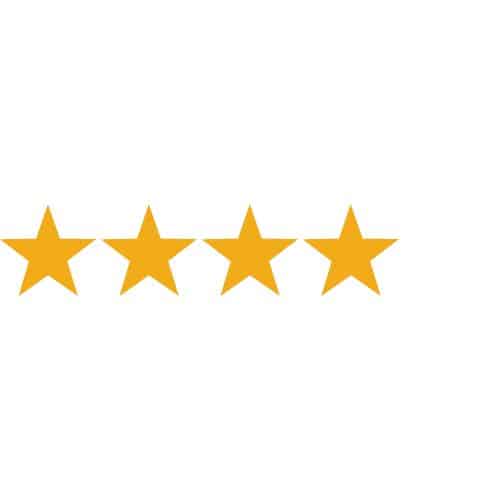
I really enjoyed reading this book. Although it didn’t give me the same excitement as a 5-star book, I can totally recommend it.
About the author
Judson Brewer is an American psychiatrist, neuroscientist and author.
He has developed and tested mindfulness programmes to change habits, including both in-person and app-based treatments for smoking, emotional eating and anxiety. Therefore, he has over 20 years of experience in mindfulness training and scientific research.

Leave a Comment Cancel Reply
Your email address will not be published. Required fields are marked *
Save my name, email, and website in this browser for the next time I comment.
Privacy Overview
- Bipolar Disorder
- Therapy Center
- When To See a Therapist
- Types of Therapy
- Best Online Therapy
- Best Couples Therapy
- Best Family Therapy
- Managing Stress
- Sleep and Dreaming
- Understanding Emotions
- Self-Improvement
- Healthy Relationships
- Student Resources
- Personality Types
- Guided Meditations
- Verywell Mind Insights
- 2024 Verywell Mind 25
- Mental Health in the Classroom
- Editorial Process
- Meet Our Review Board
- Crisis Support
How to Unwind Your Anxiety With Neuroscientist Dr. Jud Brewer
Amy Morin, LCSW, is a psychotherapist and international bestselling author. Her books, including "13 Things Mentally Strong People Don't Do," have been translated into more than 40 languages. Her TEDx talk, "The Secret of Becoming Mentally Strong," is one of the most viewed talks of all time.
:max_bytes(150000):strip_icc():format(webp)/VW-MIND-Amy-2b338105f1ee493f94d7e333e410fa76.jpg)
Verywell / Julie Bang
Meet Dr. Jud Brewer
Why dr. brewer is mentally strong, what you’ll hear on the show, what you’ll learn about anxiety and mental strength, quotes from dr. brewer, more about the podcast.
On The Verywell Mind Podcast , Amy Morin, LCSW, interviews experts, authors, entrepreneurs, athletes, musicians, and other inspirational people about the strategies that help them think, feel, and do their best in life.
Subscribe Now : Apple Podcasts / Spotify / Google Podcasts
Dr. Jud Brewer is a psychiatrist and a neuroscientist. He’s spent more than 20 years researching habit change and the “science of self-mastery.”
He developed a deep understanding of how our brains work and he uses that knowledge to help other people create lasting change in their lives.
He’s the Director of Research and Innovation at the Mindfulness Center, associate professor in psychiatry at the School of Medicine at Brown University, the executive medical director at Sharecare and a research affiliate at MIT.
His newest book, Unwinding Anxiety, became an instant New York Times bestseller. He also created an app that helps people change unwanted behaviors, such as smoking and emotional eating.
Dr. Brewer invests his time into learning and teaching people how to create positive changes in their lives.
But he also says he’s not conducting “research” he’s conducting “me-search.” He’s quite up front about his own anxiety and habits and how he applies his work to his own life.
And while he is a psychiatrist who can prescribe medication, he doesn’t insist prescriptions are the best option for everyone. He’s combined modern-day science with ancient wisdom. The strategies he teaches people have been found to be more effective at relieving anxiety than medication.
- Why 80% of people don’t benefit from anxiety medication
- How curiosity can be a form of mindfulness
- How to recognize your physical symptoms of anxiety
- Why The Simpsons theme songs causes my anxiety to spike and Dr. Jud’s input about how to deal with it
- How to stop resisting uncomfortable emotions like anxiety
- Why we’re all addicted to something
- Why mindfulness training can be more effective than medication and other treatment options
- The primal reasons we develop unhealthy habits
- Why we worry so much (and what we get out of it)
- Why we don’t realize when our habits are becoming “too often” or “too much”
- How to better understand your brain and your body’s response to anxiety
Sometimes people assume mental strength is the absence of mental health struggles. But that’s not true.
Building mental muscle can help you stay healthier. But it doesn’t mean you won’t experience struggles and discomfort along the way.
In fact, mental strength involves allowing yourself to experience and express uncomfortable emotions, rather than suppress them.
Anxiety is an emotion most people go to great lengths to avoid. But learning how to tolerate it a little more could be the key to freeing yourself from anxiety. Dr. Jud shares how to allow yourself to experience an uncomfortable emotion without running from it.
Dr. Jud Brewer
Habits form through what's called reinforcement learning . If something's pleasant or feels good, our brains are going to learn to do that again. If something's unpleasant, our brain is going to say, ‘Hey, make that go away.’
- If we distract ourselves, we're not solving the anxiety.
- We don't pay attention and ask the questions. Is this actually helping? Or is this just giving me some brief relief and then ultimately going to make things worse in the long run?
- Anxiety tends to make us feel closed down, contracted and tightened into a little ball. Curiosity does the opposite.
- When we're starting to get tightened up with a little bit of anxiety, it can be harder for us to use the thinking part of our brain. So the first thing I do is have people ground themselves in their present moment experience.
The Verywell Mind Podcast is available across all streaming platforms. If you like the show, please leave us a review on Apple Podcasts .
Reviews and ratings are a great way to encourage other people to listen and help them prioritize their mental health too.
Links and Resources
- Visit Dr. Jud’s website
- Watch Dr. Jud’s Ted Talk: A Simple Way to Break a Bad Habit
- Buy Dr. Jud’s book Unwinding Anxiety
- The Characteristics of High Functioning Anxiety
- Friday Fix: The First Step in Taming Your Anxiety
By Amy Morin, LCSW Amy Morin, LCSW, is a psychotherapist and international bestselling author. Her books, including "13 Things Mentally Strong People Don't Do," have been translated into more than 40 languages. Her TEDx talk, "The Secret of Becoming Mentally Strong," is one of the most viewed talks of all time.

- Stress Management
Buy new: .savingPriceOverride { color:#CC0C39!important; font-weight: 300!important; } .reinventMobileHeaderPrice { font-weight: 400; } #apex_offerDisplay_mobile_feature_div .reinventPriceSavingsPercentageMargin, #apex_offerDisplay_mobile_feature_div .reinventPricePriceToPayMargin { margin-right: 4px; } -15% $22.04 $ 22 . 04 Ships from: Amazon Global Store UK Sold by: Amazon Global Store UK
Amazon global store.
- International products have separate terms, are sold from abroad and may differ from local products, including fit, age ratings, and language of product, labeling or instructions.
- Manufacturer warranty may not apply
- Learn more about Amazon Global Store.
Save with Used - Good .savingPriceOverride { color:#CC0C39!important; font-weight: 300!important; } .reinventMobileHeaderPrice { font-weight: 400; } #apex_offerDisplay_mobile_feature_div .reinventPriceSavingsPercentageMargin, #apex_offerDisplay_mobile_feature_div .reinventPricePriceToPayMargin { margin-right: 4px; } $17.54 $ 17 . 54 FREE delivery Tuesday, June 11 on orders shipped by Amazon over $35 Ships from: Amazon Sold by: Books For You Today
Return this item for free.
Free returns are available for the shipping address you chose. You can return the item for any reason in new and unused condition: no shipping charges
- Go to your orders and start the return
- Select your preferred free shipping option
- Drop off and leave!

Download the free Kindle app and start reading Kindle books instantly on your smartphone, tablet, or computer - no Kindle device required .
Read instantly on your browser with Kindle for Web.
Using your mobile phone camera - scan the code below and download the Kindle app.

Image Unavailable

- To view this video download Flash Player

Follow the author

Unwinding Anxiety: Train Your Brain to Heal Your Mind Paperback – March 11, 2021
Purchase options and add-ons.
- Print length 320 pages
- Language English
- Publisher Vermilion
- Publication date March 11, 2021
- Dimensions 5.28 x 1.1 x 8.43 inches
- ISBN-10 1785043633
- ISBN-13 978-1785043635
- See all details

Frequently bought together

Similar items that may deliver to you quickly

Get to know this book
Popular highlight

From the Publisher

Product details
- Publisher : Vermilion; International Edition (March 11, 2021)
- Language : English
- Paperback : 320 pages
- ISBN-10 : 1785043633
- ISBN-13 : 978-1785043635
- Item Weight : 2.31 pounds
- Dimensions : 5.28 x 1.1 x 8.43 inches
- #1,497 in Stress Management Self-Help
Videos for this product

Click to play video

Unwinding Anxiety Book - Honest Review
alittlebitofeverything ⭐⭐⭐⭐⭐

recommend if wanting to learn more about anxiety
Darsity Birling

About the author
Judson brewer.
Jud Brewer MD PhD is a thought leader in the field of habit change and the “science of self-mastery”, having combined over 20 years of experience with mindfulness training with his scientific research therein. He is the Director of Research and Innovation at the Mindfulness Center and associate professor in Behavioral and Social Sciences and Psychiatry at the Schools of Public Health & Medicine at Brown University. He also is a research affiliate at MIT. A psychiatrist and internationally known expert in mindfulness training for addictions, Brewer has developed and tested novel mindfulness programs for habit change, including both in-person and app-based treatments for smoking, emotional eating, and anxiety. He has also studied the underlying neural mechanisms of mindfulness using standard and real-time fMRI and EEG neurofeedback. He has trained US Olympic athletes and coaches, foreign government ministers, and his work has been featured on 60 Minutes, TED (4th most viewed talk of 2016, with 14+ Million views), Time magazine (top 100 new health discoveries of 2013), Forbes, BBC, NPR, Al Jazeera (documentary about his research), Businessweek and others. His work has been funded by the National Institutes of Health, American Heart Association, among others. Dr. Brewer founded MindSciences to move his discoveries of clinical evidence behind mindfulness for anxiety, eating, smoking and other behavior change into the hands of consumers (see www.drjud.com for more information). He is the author of The Craving Mind: from cigarettes to smartphones to love, why we get hooked and how we can break bad habits (New Haven: Yale University Press, 2017). Follow him on twitter @judbrewer.
Customer reviews
Customer Reviews, including Product Star Ratings help customers to learn more about the product and decide whether it is the right product for them.
To calculate the overall star rating and percentage breakdown by star, we don’t use a simple average. Instead, our system considers things like how recent a review is and if the reviewer bought the item on Amazon. It also analyzed reviews to verify trustworthiness.
Reviews with images

- Sort reviews by Top reviews Most recent Top reviews
Top reviews from the United States
There was a problem filtering reviews right now. please try again later..
Top reviews from other countries
- Amazon Newsletter
- About Amazon
- Accessibility
- Sustainability
- Press Center
- Investor Relations
- Amazon Devices
- Amazon Science
- Sell on Amazon
- Sell apps on Amazon
- Supply to Amazon
- Protect & Build Your Brand
- Become an Affiliate
- Become a Delivery Driver
- Start a Package Delivery Business
- Advertise Your Products
- Self-Publish with Us
- Become an Amazon Hub Partner
- › See More Ways to Make Money
- Amazon Visa
- Amazon Store Card
- Amazon Secured Card
- Amazon Business Card
- Shop with Points
- Credit Card Marketplace
- Reload Your Balance
- Amazon Currency Converter
- Your Account
- Your Orders
- Shipping Rates & Policies
- Amazon Prime
- Returns & Replacements
- Manage Your Content and Devices
- Recalls and Product Safety Alerts
- Conditions of Use
- Privacy Notice
- Consumer Health Data Privacy Disclosure
- Your Ads Privacy Choices
- Cast & crew
Inside Out 2

Follow Riley, in her teenage years, encountering new emotions. Follow Riley, in her teenage years, encountering new emotions. Follow Riley, in her teenage years, encountering new emotions.
- Kelsey Mann
- Dave Holstein
- Meg LeFauve
- Amy Poehler
- Phyllis Smith
- Lewis Black

- Embarrassment

- Riley Andersen

- Mrs. Andersen

- Mr. Andersen

- Valentina 'Val' Ortiz

- Coach Roberts

- Subconscious Guard Frank

- Subconscious Guard Dave

- Forgetter Bobby

- Forgetter Paula
- All cast & crew
- Production, box office & more at IMDbPro
The Big List of Summer Movies

More like this

Did you know
- Trivia The first trailer received 157 million online views within the first 24 hours, more than any other Disney animated film, surpassing Frozen II (2019) , with 116 million views.
Riley Anderson : [from the trailer] I'M THE WORST!
Mom's Anger : Welp, there's a preview of the next ten years.
- Connections Featured in AniMat's Crazy Cartoon Cast: The D23 Expo 2022 Special (2022)
- When will Inside Out 2 be released? Powered by Alexa
- June 14, 2024 (United States)
- United States
- Instagram - Disney's Announcement
- Instagram - Pixar's Announcement
- Những Mảnh Ghép Cảm Xúc 2
- Walt Disney Feature Animation - 500 S. Buena Vista Street, Burbank, California, USA (Studio)
- Walt Disney Pictures
- Pixar Animation Studios
- See more company credits at IMDbPro
Technical specs
- Runtime 1 hour 40 minutes
- Dolby Digital
- Dolby Atmos
- 12-Track Digital Sound
- D-Cinema 96kHz Dolby Surround 7.1
- D-Cinema 96kHz 7.1
Related news
Contribute to this page.

- See more gaps
- Learn more about contributing
More to explore
Recently viewed.
- lol Badge Feed
- win Badge Feed
- trending Badge Feed
Browse links
- © 2024 BuzzFeed, Inc
- Consent Preferences
- Accessibility Statement
Beauty + Personal Care
Sports + Fitness
- Trending badge Trending
We hope you love our recommendations! Some may have been sent as samples, but all were independently selected by our editors. Just FYI, BuzzFeed and its publishing partners may collect a share of sales and/or other compensation from the links on this page.
36 Screen-Free Products To Unwind With After Working On A Computer All Day
You don't *always* have to leave the TV on, ya know.

BuzzFeed Staff
1. Taco Cat Goat Cheese Pizza — a card game you can play at home alongside your friends while cuddled up in your comfiest sweats. Hope you're all ready for endless giggles!
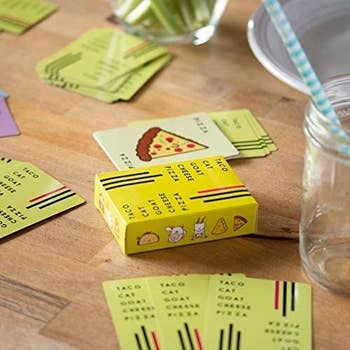
Dolphin Hat Games is a small business that specializes in family-friendly card games
You deal all the cards out to your two to four players, and everyone keeps their mini-deck face down. Everyone takes a turn putting a card down in the middle of the table, saying one of the words "taco," "cat," "goat," "cheese," and "pizza," in that order. If the picture on your card matches the word that's said, everyone slaps their hand on the card in a pile as quickly as possible. The last person on the pile has to take the stack and add 'em to their cards, and whoever runs out of cards first wins!
Get it from Amazon for $9.84 .
2. A " Liquipen " for anyone who grew up with a lava lamp but knows setting one up at their desk probably isn't *ideal*. Watching the little blobs float up and down will ease your mind and give you a chance to regroup.
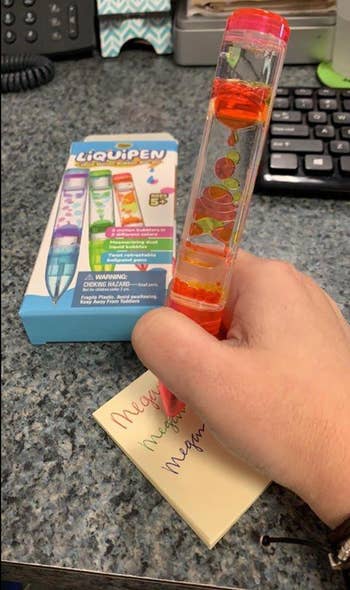
Promising review: "I broke up the three-pack and gave one pen as a gift for a class gift exchange and put the other two in stockings for Christmas. Good quality and approved by both the 8-year-old and 49-year-old husband who is a kid at heart! Definitely recommend." — Kindle Customer
Get a set of three from Amazon for $19.99 .
3. A set of Monkey Noodles that stretch up to 8 feet (!?!??) and will provide anyone with a non-disruptive way to scratch their fidgety itch. Perfect for anyone looking to relieve some pent up anxiety without leaving their desk.
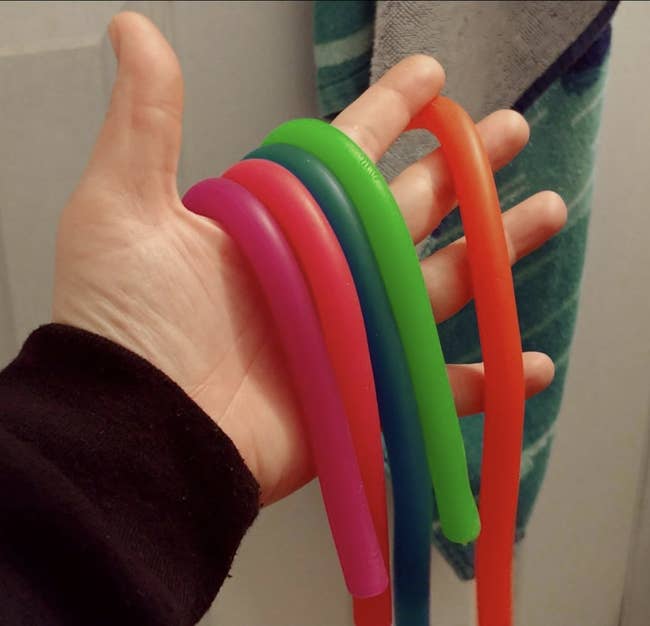
Promising review : "This is my absolute favorite fidget! I’m an adult with autism and ADHD. I carry one around with me everywhere I go. It definitely assists me in staying calm/still while I’m at work. I’ve recommended it to several friends!" — KaelynnVP
Get a set of five from Amazon for $12.99 .
4. Crayola Globbles , a fun lil' toy you can use to burn off some steam in between meetings or when you just need a quick mental break. Don't worry, they won't leave residue on your walls.
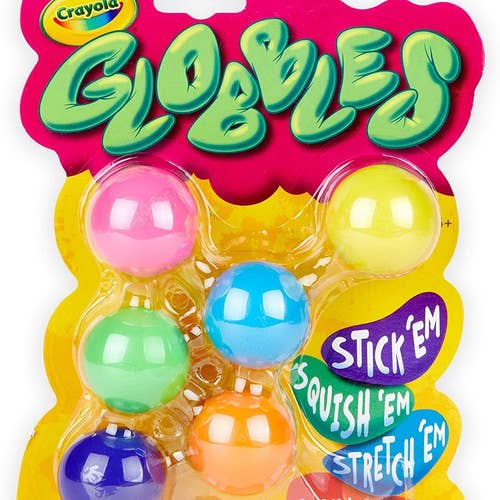
Promising review : " I waited over two months to write my review! My daughter is four and plays with these DAILY! YES they do attract dirt and hair HOWEVER they are so easy to rinse off, it's not a big deal! We took these to a family gathering and ended up giving two away because they were SO loved! The two we gave away went to a 12-year-old and my 19-year-old brother. They discovered throwing them at the ceiling fan and watching them shoot across the room which was pretty entertaining! None of these have busted or ripped and they are definitely NOT gentle with them! I will definitely be buying more! " — Kindle Customer
Get a pack of six from Amazon for $10.69 .
5. An activity book that has been specifically designed for the writer to destroy once they've finished it — you'll get the chance to dig deep into their past, present, and future without any pressure to commit to daily journaling.
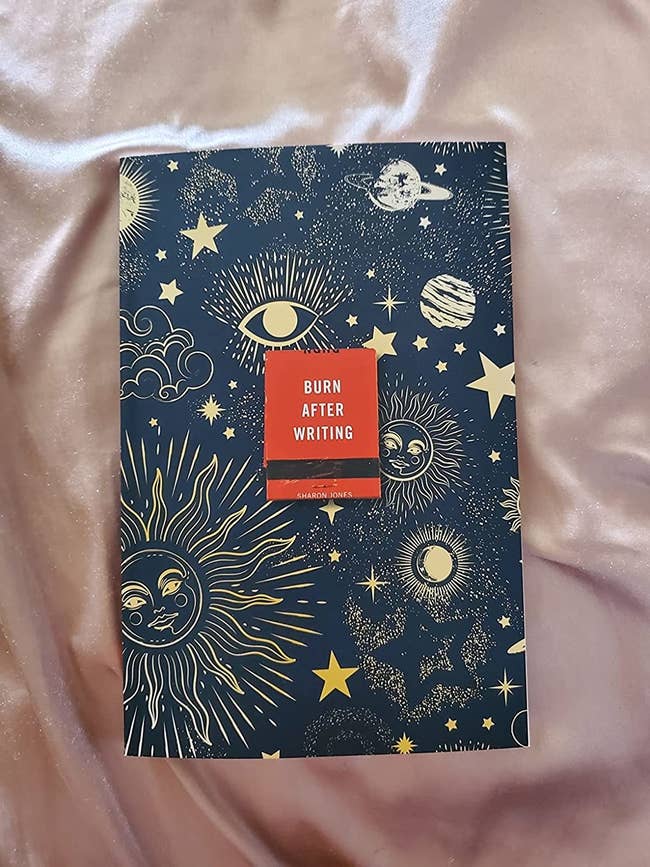
...and the celestial design on the front is stunning, if I do say so myself.
Promising review: "This book helps you understand that it’s okay to be completely honest with yourself. The book itself was in great condition with clean pages. I can’t wait to venture more into this lil' journey with myself ♥️" — Molls
Get it from Amazon for $7.32 .
6. Or a Wreck This Journal to encourage you to get more in touch with your artistic side, great if you've been intimidated by trying to fill out the blank pages of boring old regular journals. This journal may not start out as a personalized item, but it'll certainly be one when you're done with it.
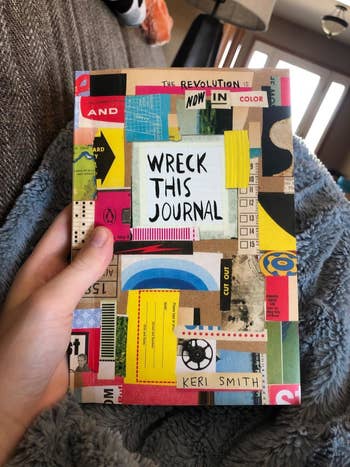
Promising review: "I’m 17 and I loved this. In the intro it says the page instructions are all up to interpretation, so if it says 'spill your drink' or something you can take that literally or choose to paint on it with something such as tea or coffee that’ll look like brown watercolor. I love that it’s full of bizarre prompts but that you have wiggle room if you don’t want to do anything too crazy. I would recommend this if you’re just looking for something fun or if you’re going through some challenges this is really helpful to distract/express/push yourself! " — Marlee
Get it from Amazon for $9.59 .
7. A Nightmare Before Christmas mini cross-stitch kit for anyone who would love nothing more than to *live like Jack and Sally* and take a mental break from their real life.

Promising review: "This is a great kit perfect for any cross stitch or Nightmare Before Christmas fan. It contains a booklet with instructions and four patterns, the needed thread, three pieces of canvas, the holder and two needles. It's a really awesome set. The instructions were easy to follow, and I managed to already finish one of the designs." — witchykitty39
Get it from Amazon for $6.72 .
8. And a friendship bracelet making kit , because if there's anything we can take away from The Swifties it's that trading little signs of affection in the form of jewelry is not just for kids.

I bought this kit ahead of attending The Eras Tour and would recommend also buying an additional letter set . For reasons I cannot explain, this one doesn't come with any vowels. 😅 However, the rubbery beads are perfect and very easy to slide onto the clear string that comes with the kit. I loved adding in the gold star and circle dividers to add some extra pizzazz to my bracelets. The little scissor in the kit was also great for seamlessly cutting the string. They were rather soothing to craft and I had a blast sharing them with other fans at the concert. Definitely get it!
Promising review: "I received this kit yesterday and so far my friend and I have made five bracelets, one anklet and a necklace. Would 10/10 recommend getting one of these kits for yourself, a friend or someone with a birthday coming up!" — Gail
Get it from Amazon for $6.99 .
9. Bananagrams – it'll *lit*erally bring a smile to any bookworm's face — it combines all the fun of crossword puzzles and Scrabble for a fast-paced game anyone who loves words will appreciate.

Bananagrams is a small business!
Promising review: "Definitely a lot of fun! Got this for a friend after having bought two previous versions for us and for some cousins. Everybody loves playing it and ends up spending hours at a time! Helps you learn new words and while not exactly Scrabble, knowing a bunch of two letter words comes in handy when you're trying to win!" — Minion
Get it from Amazon for $13.99 .
Check out our full review of Party Bananagrams (#2 in the post)!
10. The Great British Baking Show game, a must-buy if you religiously watch all the seasons so you'll have something to do once your finish all of the episodes (or just want a break from staring at the TV).
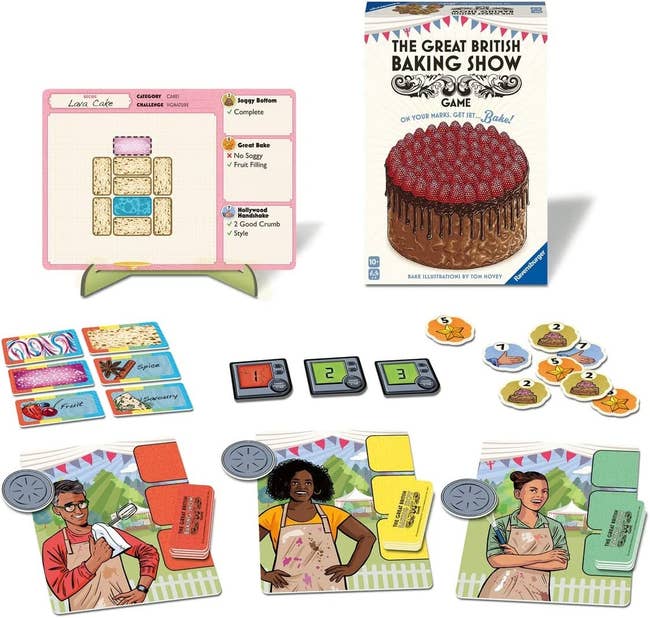
Promising review: "This is a fun and fast-paced game for the GBBS fan and gamer alike. One of the things I like about the game is that familiarity with the show adds a fun element to it, but even for people who's never watched it the game is fun. There's nothing really deep or strategic about the game, but it's fun. As noted in the description, there's a video you can search for that shows you how to play the game , though the directions are good. I watched it prior to ordering the game to get a sense of it. The box is solid and the game pieces are well-made (typical cardboard pieces, quality)" — M. Fisher
Get it from Amazon for $24.99 .
11. And How To Bake , a cookbook from The Great British Baking Show 's Paul Hollywood to encourage you to take a break from staring at your many screens to bake something delicious.
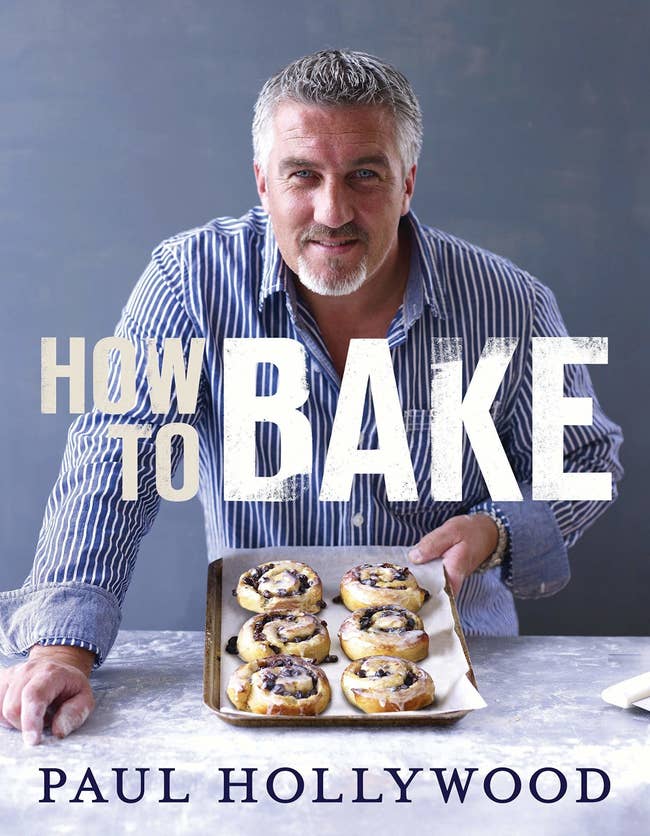
Reviewers agree that the instructions are clear, photos with *each* recipe are super helpful, and the step-by-step instructions helped them get amazing results on their first try.
Since he's British, the book uses metric measurements (and weighing ingredients is really better for precise baking!) so you might also want to get a handy kitchen scale if you don't have one. You can get a top-rated one from Amazon for $11.99 .
Get it from Amazon for $21.83 .
12. A plush bath pillow , so you can happily lounge and read the novel you've been dying to crack open from cover to cover comfortably.
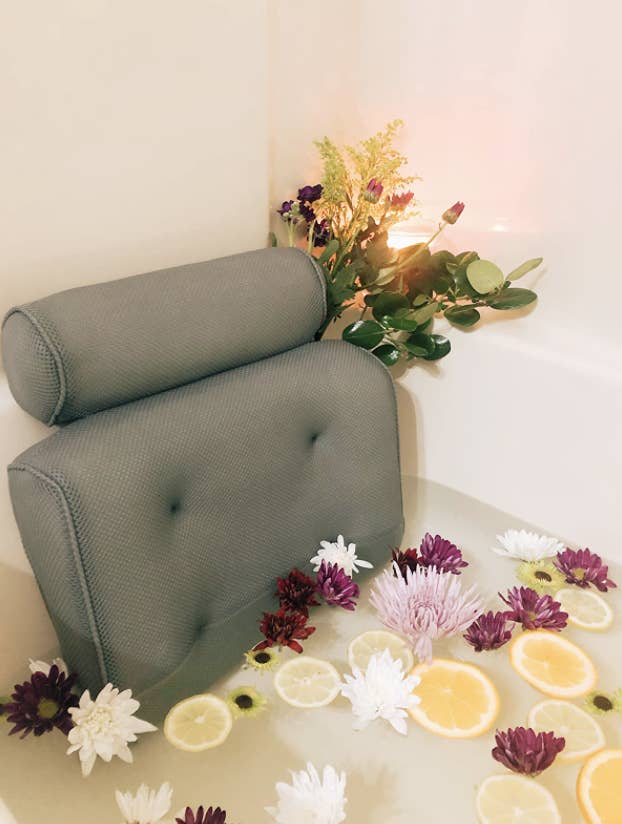
Promising review: "This has a lot of cushion for your back and neck. I had no issues with sticking it to the tub. The best part is the hook which allows it to dry out well. In this time of working at home, I need a nice tub to help relax." — Danielle Piacentini
Get it from Amazon for $31.99 .
13. And a teak bath caddy to give yourself just one more reason to fill your tub to the brim and soak for hours while listening to Enya.

Promising review: "Well made, pretty tray that fits all the way across my tub. Has a support for book or iPad which is great." — Jolene Saiz
Get it from Amazon for $36.99+ (available in two styles).
14. An electric waterproof bubble massage mat complete with a built-in heater and an aroma clip for essential oil aromatherapy. Just imagine how wonderful this will feel after a long workout or a long day spent outdoors.

Promising review: " This product provides a great massage technique for my back muscles. I experience a lot of pain and tension in my shoulders. And I have chronic pain in my lower back. I also like the aromatherapy pad. What a great, soothing, and relaxing experience for the low cost." — Octavia
Get it from Amazon for $135.99 .
15. A set of bath bombs to toss into the tub and use to unwind after a particularly stressful day and watch your worries ~fizzle~ away.
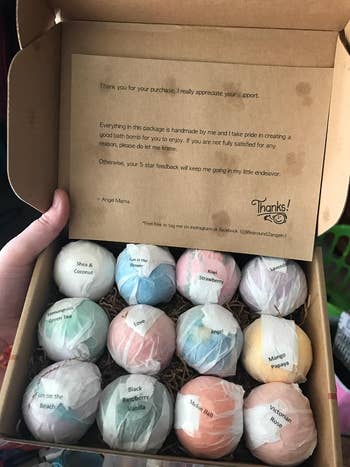
LifeAround2Angels is a small business!
Promising review: "I ABSOLUTELY LOVE THESE BATH BOMBS!!!! I think they are fun in terms of the packaging, the names, the colors and the little 'extras' mixed in the bombs. I personally feel they are just the right size and love the colors. The first time around I was concerned about the color part but no worries — doesn't stain the tub. They are very moisturizing for the long tough New York winter we are experiencing this year; my skin tends to be dry but using these bath bombs on a regular basis has helped to keep my skin nice and soft. And the number of bath bombs in the set along with the price is just right!" — Pamela
Get a set of 12 from Amazon for $20.80 .
16. Or a set of relaxing shower steamers you can add into your morning or nightly rinse to transform a typically quick chore into a spa-like experience.
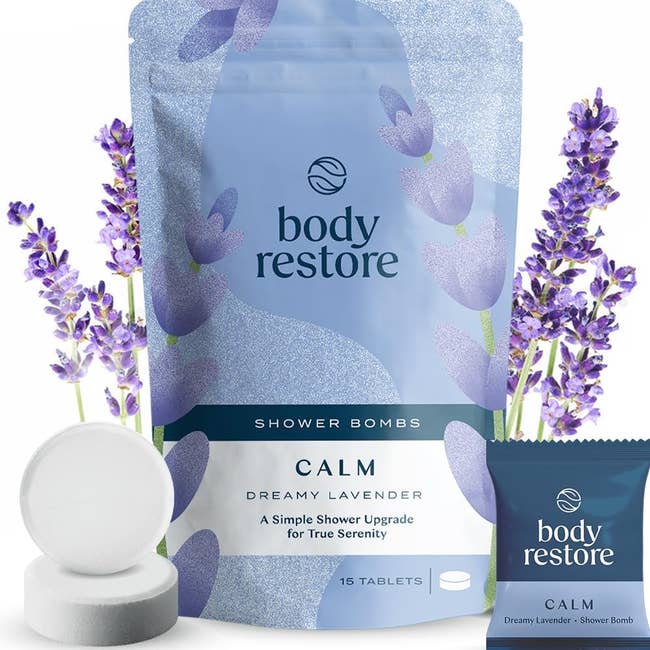
Body Restore is a small business!
Promising review: "I kept seeing this product pop up on TikTok so I decided to buy a pack and I'm SO GLAD I DID! These smell so good and are a perfect way to relax while in the shower. I now recommend them to everyone I know!" — Merry
Get a pack of 12 from Amazon for $29.99 .
17. A heated eye massager complete with five different massage modes and Bluetooth music so you can fully indulge and relax while relieving pain from eye strain and headaches.
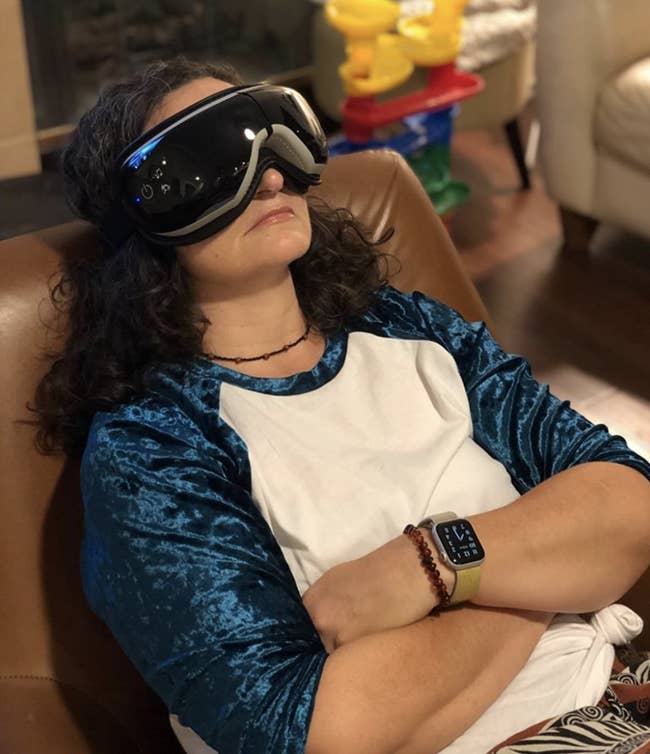
Promising review : "I saw this product on one of Amazon’s must-have TikTok videos and I knew I had to get it. It was so worth it — even though price may seem higher compared to other sellers, this is for sure a good investment piece. The quality is top-notch, the strap that goes around your head is comfortable, and most importantly, the duration of each mode is long enough that it doesn’t interrupt your rest. I work a 12-hour night shift as a nurse and this technology has helped me get through the night easily.👍🏽👍🏽👍🏽" — Amazon Customer
Get it from Amazon for $62.99+. (available in three colors).
18. A copy of The Big Activity Book for Anxious People , perfect for distracting your brain for a while and forcing you to change your mindset by living in the moment. Definitely a great option to have in your anxiety fighting tool kit.
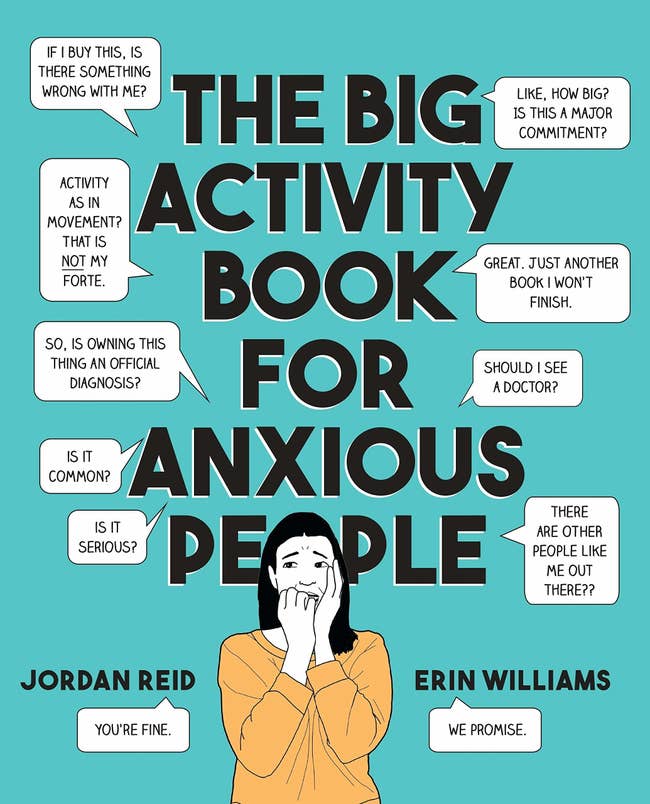
Promising review : "Love this book! I suffer from anxiety and even though I have the coping skills to 'deal' with it, when it rears its head I do get set back a little bit. So I got this book thinking 'okay, it will give me something to do so I can be in the moment' but it is so much more!!! It's funny (makes me laugh out loud), creative, interesting, and reminds me that I am not the only person to feel anxiety and how horrible it can make you feel. So all I have to ask the authors is 'Can you make a book for depression?'" — Catmom
Get it from Amazon for $14.40 .
19. A carbonated bubble clay mask that starts to bubble once it's applied — get one for you and each of your roomies and prepare for a fun night filled with stress-evaporating giggles (all the while banishing your blackheads).

Promising review: "Wow! I purchased this on a whim after seeing one of my favorite YouTubers try it out. I didn't expect a lot from it. I tried it out and was shocked!!! The mask was simple (and fun) to use. I wasn't sure I felt a lot happening while it was on, but it was pretty cool how the bubbles started to grow off of my face. Upon inspection after using this mask I was completely amazed. My face felt cleaner than it has in a very long time AND my pores looked amazing! I don't remember a time when I felt like my pores looked great before using this mask. I would highly recommend this mask to anyone. It's also so much cheaper than the GlamGlow ones I have been using (and didn't see near these results from)." — K. Textor
Get it from Amazon for $9.50 .
20. An ice roller , which is said to help decrease under-eye puffiness, minimize fine lines, and shrink the look of pores — as well as to relieve headaches and sore muscles. Your skin will thank you.
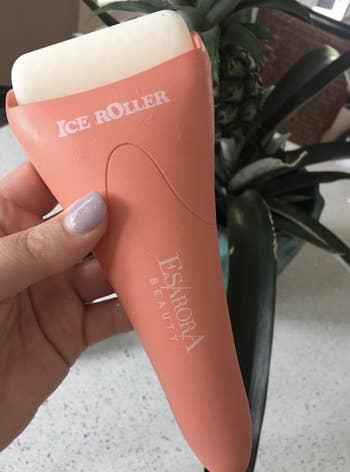
This is my favorite thing to start my pampering with, but I also use it in the morning before I apply any makeup. All you have to do is pop the separate roller piece into your freezer and you'll be ready to de-puff in no time.
Promising review: "I use this ice roller in my esthetician treatment room after extractions, peels and/or waxing. My clients love it! It drastically reduces inflammation and swelling...thereby leaving the skin in a much healthier state than if I didn't use it. I actually prefer this to my magic globes because of the ease of rolling over the skin. Globes tend to skip/jump if the skin is not properly lubricated with a lot of product. I can apply a calming colloidal oatmeal masque (in powder form) or other setting masque and simply roll right over it. If it is too chilly for your client...simply put a damp esti wipe on the skin as a barrier. Very easy to clean and disinfect between clients." — Chris DeFelice
Get it from Amazon for $10.99+ (available in 12 colors).
21. A waterproof Bluetooth speaker you can clip onto your shower curtain rod and pump in soothing nature sounds to truly give your bathroom a spa-like aesthetic.
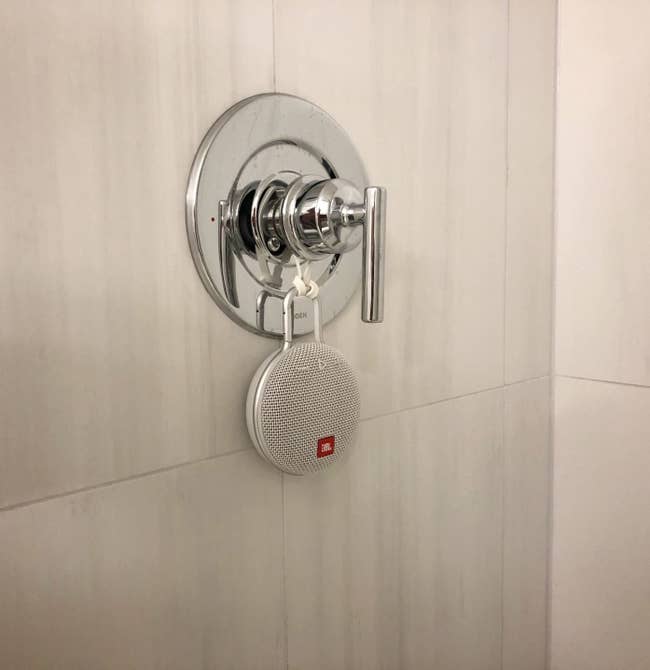
Promising review: "Sounds pretty good for a single little speaker. Battery life is great. Unlike every other Bluetooth device in the world, including other JBL portable speakers, this one stays connected, and disconnected, when I want it to. It looks good, I like the clip, and it seems sufficiently waterproof to hang in my shower (albeit in a relatively dry area of the shower). Perfect in the niche role I've selected it for!" — Jeremy Modjeska
Get it from Amazon for $39.79+ (available in 12 colors).
22. A scratch paper art set that'll take you right back to your elementary school days but also provide a fun way to de-compress.

Promising review: "I bought these to help entertain children at a big dinner party, and they were a huge hit! Ages 3–10 loved them! You can use them easily to make a small, simple design or something more elaborate. The kids loved them and I will purchase again. Great purchase!" — Rachel Castlen
23. A 1,000-piece Mystic Maze puzzle , perfect for helping you unwind after a day filled with unpleasantries. There are over 50 hidden Easter eggs in this journey of an activity (including a hidden twist at the end!) that'll delight and amaze anyone who works on it.
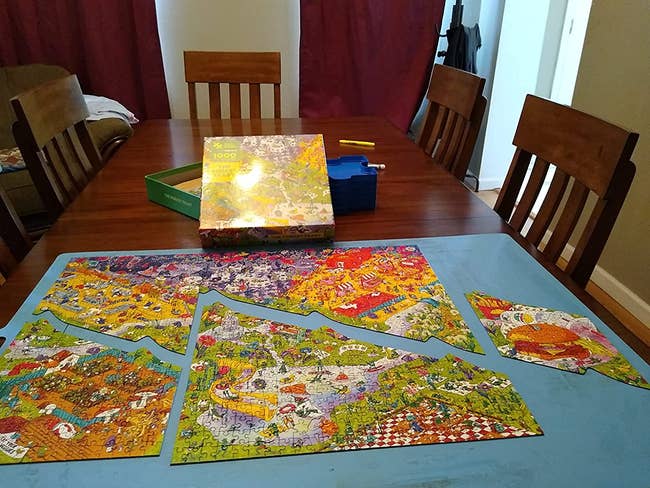
You can check out a TikTok of a Mystic Maze puzzle in action (but warning, it will spoil the surprise!).
Promising review: "10/10 recommend this puzzle! So fun and kept you entertained the whole time. Perfect gift for someone who loves puzzles and wants a fun experience. Pieces were great quality and the art is great. Each time I look at the puzzle I find something new. Can’t say enough good things about this. Hope they continue to make more!" — Mary B. Owczarski
Get it from Amazon for $22.99 .
24. A Beauty of Horror coloring book anyone would find to be simply gore geous and a great way to burn off some stress.
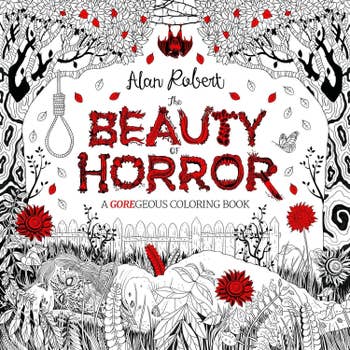
Promising review: "Love this coloring book! It combines the haunted fun of Halloween with a creepy twist. Perfect for relaxing and escaping from anxiety!! The pages are nice and thick. No issues coloring with markers. Definitely recommend!" — Amazon Customer
Get it from Amazon for $12 .
25. Or an adult coloring book starring Disney animals filled with intricate designs, so they can relax and listen to their favorite Disney songs while coloring in pages inspired by Disney's 100-year history.
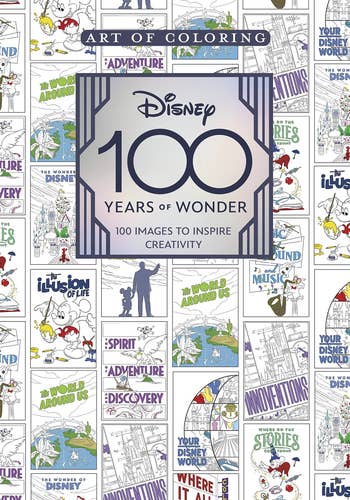
Promising review: "I really love all the information included with each page and the inspiration from Walt Disney’s own words." — panda
Get it from Amazon for $11.16 .
26. A massage roller you can use to apply acupressure on the bothersome parts of your feet to make them feel fantastic before heading off to bed.
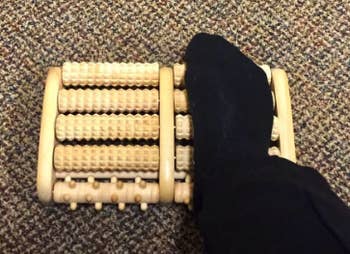
Promising review: "I’ve been having so many issues with my feet the last few years. My feet hurt so bad, it’s made me become a hermit. I’ve had tendinitis in both and now plantar fasciitis. I get foot cramps all the time. After just one day with this under my desk at work, I feel a huge difference. My feet no longer feel tight and painful. They feel tingly — in a good way. I look forward to being able to go for a walk and not have to rest along the way. I know it’s meant for feet but I may try it out on my calves. I also love that it’s small, looks nice and doesn’t slide around. I highly recommended this for anyone, foot issues or not, if you sit a lot. Nice way to keep the blood flowing when stuck at a desk." — Vanessa Thomas
Get it from Amazon for $14.99 (also available in another style).
27. A Renpho percussion massager — a must-have if you’re forever complaining about the knots in your back and wishing you could take a daily trip to the spa.
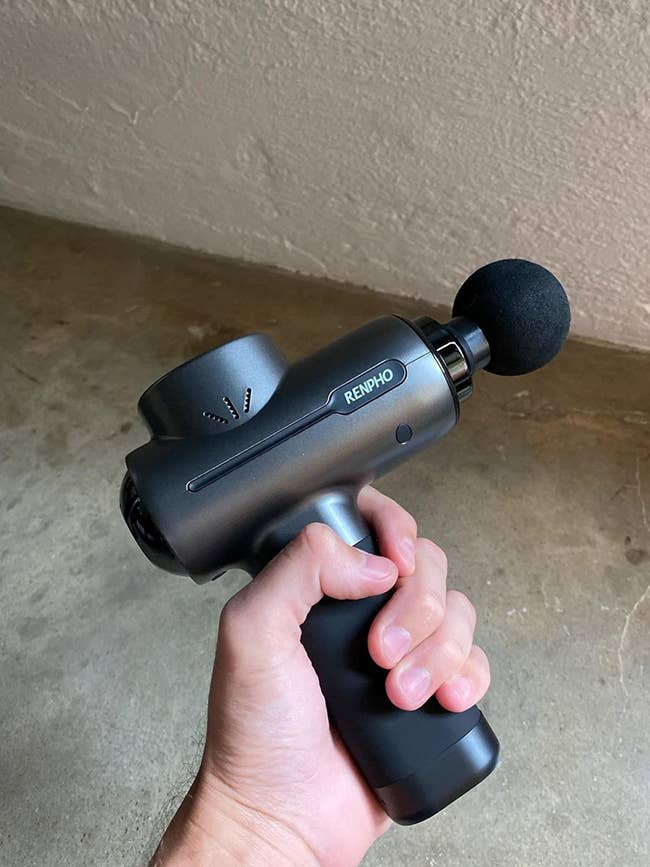
Check out a TikTok of the massager in action.
Promising review: " I have tried EVERYTHING for my feet, nothing works and I am always in pain. It came, and I opened the box to find an UNUSED, BRAND-NEW massage gun with all the attachments. I tried it out and I thought wow, that feels AWESOME. But the true test is how do you feel the next day right? You cannot always walk around with a massage gun in your hand. The next day, I felt AMAZING. AMAZING. I used it on my hubby's back too, and he said he felt so much better today as well! In addition, this one is way QUIETER than my original massage gun. It's just really a quality piece. You won't be disappointed in this one. It really is what it says. I know it is hard to choose from all the models on the internet, but this one is the real deal. It's worth the money if you have pain." — L Johnson
Get it from Amazon for $69.99+ (available in three colors).
28. The Spells Deck , filled with cards of charms, remedies, and rituals for self-care you can shuffle through while humming "I Put A Spell On You" and likely frightening your parents.
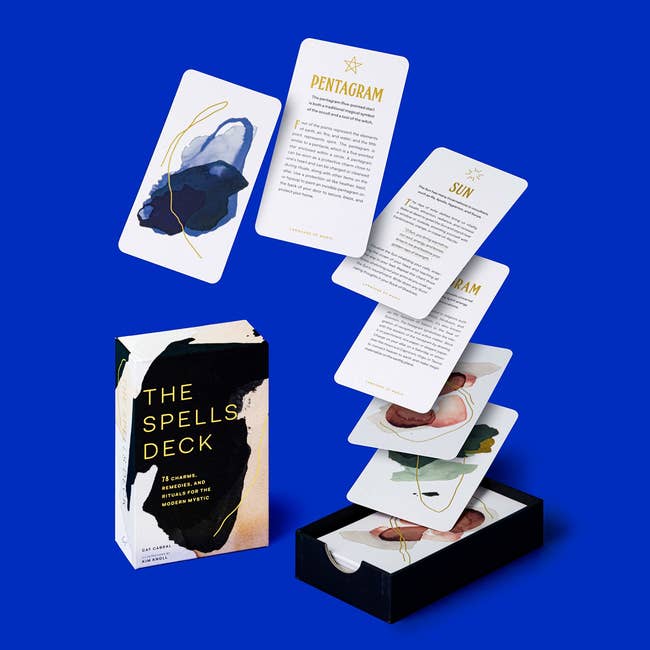
The deck includes 78 cards and is an all-levels introduction to witchcraft. Each card features artwork on the front and simple instructions for a spell on the back.
Promising review: "I love these cards! I’ve only had them for a couple of weeks and they have already proven to be inspirational, whimsical, and magical. I cannot wait to reference them for many years to come." — Maggie M.
Get it from Amazon for $14.99 .
29. The Magical World of Disney Trivia game — a must-have for any Disney family who thinks they know all there is to know about every film.
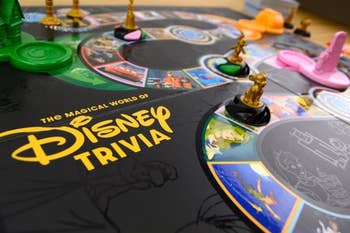
Promising review: "This is a really nice game for Disney fans. The box comes well packed with dedicated spots for all of the pieces. (Hint: take a picture of the full box to save yourself a minute or two for the first few games!) From the box itself to the board to all of the 3D elements and cards, everything is beautifully designed, and the insert holds everything perfectly. The game can be played over and over, with 2,000 total trivia questions. I love the fact that there are two decks of cards, one visual for the kids. My kid excelled at picking out who was who from the cards (the questions are specifics about those characters), whereas the adults mostly did better with written questions. You can switch it up, too, if the written trivia questions are too hard. This makes for a fun game night for Disney fans of all ages." — M. Fisher
Get it from Amazon for $27.49 .
30. A "flaming" humidifier in case you're someone who cherishes nothing more than cozy cottagecore vibes, soothing aromatherapy, and sleeping amongst delightfully hydrated air.
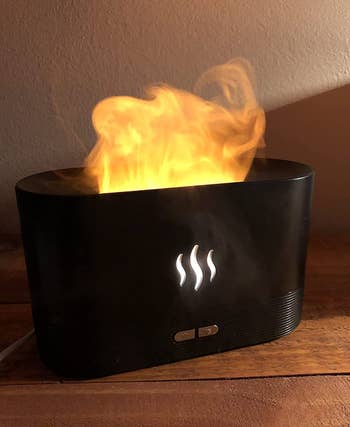
Promising review : "I like how this diffuser kind of looks like a mini fireplace and it’s perfect for winter. I also like how long the water of this diffuser lasts — I always add my favorite essential oil in it when I go to sleep every night without worrying it will run out of water. I used to have insomnia and it helped me to sleep through the night with my relaxing essential oil scent, and it also worked as a humidifier." — Benny
Get it from Amazon for $19.99+ (available in two colors and two sizes).
31. A string of 200 warm twinkle lights you can use to craft the ultimate cozy cave to hang out in.

This comes with a remote which allows you to choose between eight lighting modes (with a set timer). A USB power adapter is also included.
Promising review: "I ordered these lights for a bedroom and they were beautiful! One pack of lights was way more than I needed for one room. I had excess lights after fully hanging them around the entire room, so the length was fantastic. Perfect for bringing a nice illumination to a room. Sometimes I only have these lights on as opposed to the room's lights and it makes the room very cozy. I just ordered another set for another room!" — DHB
Get it from Amazon for $10.19+ (available in two colors and two pack sizes).
32. A foot heater for anyone with perpetually cold tootsies — fire this bad boy up, crack open a book and enjoy the warmth you’re guaranteed to feel from head-to-toe (literally).
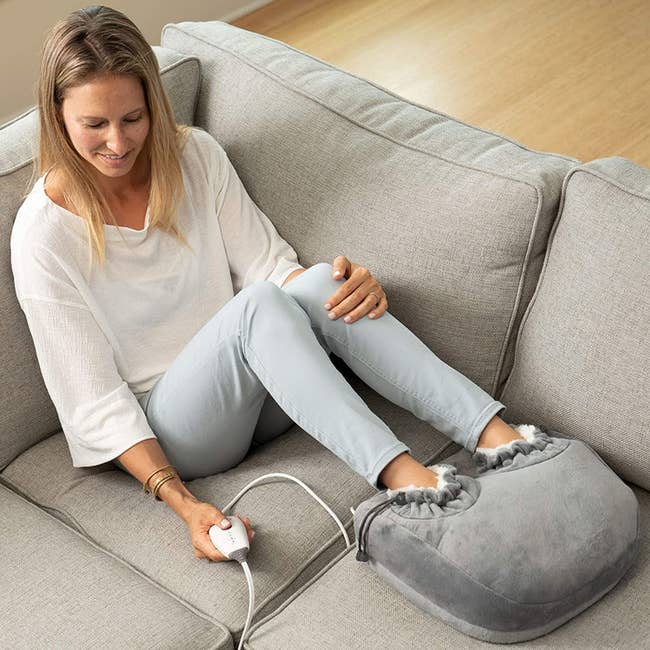
Promising review: "This is the first product I've bought that actually works! I've suffered from cold feet all my life, but no more. This foot warmer is so cozy and plush, but most important of all, it actually heats my feet on even the coldest nights! Love it!" — Killaree
Get it from Amazon for $49.99 .
33. An essential oil spray filled with the soothing scents of lavender and chamomile — spray it around before you sleep, inhale, and enjoy a long nap.

Asutra is a small business!
Promising review: "I think this spray might be helping me sleep better, but I'm not positive. What I am sure of is that it smells fantastic! I have tried other sleeping sprays (and just about every sleep product on the market for my resistant insomnia) and this is one of my favorites for just having such a great, comforting smell. It makes my bedroom feel cozier and more inviting (which can be hard for some of us who learn to hate our beds when we can't sleep). So, I think it contributes to my ability to sleep just by making my bed more inviting." — Wiwse
Get it from Amazon for $14.15 .
34. A beeswax candle kit you can use to create your very own candles to complete the cozy aesthetic you've been trying to curate in your home.

Each kit includes seven beeswax sheets with six lavender flowers, two cinnamon sticks, two dried orange slices, burlap thread, white lace, cotton wicks, two decorative bees, and instructions. To create the colors seen in the review image on the left, grab some candle dye with your purchase. Also, Candleology is a small business!
Promising review: "I purchased this set for our Hanukkah celebrations this year and made the candles with the kids. Super easy directions, and we love the outcome (pictured above, right)!" — Amazon customer
Get it from Amazon for $27.99+ (available in three styles).
35. Or a "Do Not Disturb" candle featuring the calming scents of lavender, sandalwood, and rose petals in addition to a cheeky label that says it all: do me a favor and leave me alone.

When I tell you I am wholeheartedly committed to this candle brand, I mean it. I was first introduced to them when I discovered their " OMG You're Engaged " candle in a boutique near my NYC apartment a few years ago. I've been gifting them to everyone I know (and myself) since. This small business is woman-owned by an absolute badass who also writes poetry .
Their "Do Not Disturb" candle is perfect for anyone who would benefit from a deep breath and some alone time (myself included).
Promising review: "This candle is a flex, a mood, a vibe, a look. It’s beautiful to look at and even better to smell! It makes you feel bougie and luxe. It’s been my favorite since It’s debut and I can’t go without it." — Vanessa Garcia
Get it from Evil Queen for $25 .
36. And "Sleepy" shower gel from Lush that'll bring all of the most soothing vibes you can possibly think of into your shower. It's filled with calming scents of lavender and ylang ylang oil to put you (and your skin) at ease.

This is my go-to scent from Lush — a tried-and-true favorite you'll never go wrong with. It smells *so* good and really is the perfect way to get into that bedtime mindset.
Promising review: "Sleepy is hands down my favorite smell from Lush, I want everything in it! I work a really stressful job and this is one thing I look forward to EVERY night as part of my wind down time." — Ames
Get it from Lush for $12.50+ (available in three sizes).
Reviews in this post have been edited for length and clarity.
Share This Article
- Search Menu
- Sign in through your institution
- Advance articles
- Supplement Archive
- Virtual Issues
- Editor's Choice
- Author Guidelines
- Open Access
- How to get published (video)
- Reasons to Publish
- Advertising and Corporate Services
- Advertising
- Reprints and ePrints
- Sponsored Supplements
- Branded Books
- About Pain Medicine
- About the American Academy of Pain Medicine
- About the Faculty of Pain Medicine
- Editorial Board
- Self-Archiving Policy
- Dispatch Dates
- Journals on Oxford Academic
- Books on Oxford Academic
Browse issues

Cover image

Volume 25, Issue 6, June 2024
Virtual reality cybersickness and the headache patient.
- View article
Acute, Regional Anesthesiology & Perioperative Pain Section
Technical note, ultrasound guided quadro-iliac plane block: another novel fascial plane block, education & training section, original research article, a 10-year analysis of application and match rates for pain medicine training in the united states, primary care & health services section, changes in opioid prescribing and prescription drug monitoring program utilization following electronic health record integration—massachusetts, 2018.
- Supplementary data
Psychology, Psychiatry & Brain Neuroscience Section
Review articles, biphasic effects of cannabis and cannabinoid therapy on pain severity, anxiety, and sleep disturbance: a scoping review, psychologically based interventions for adults with chronic neuropathic pain: a scoping review, clinical perspectives, teaching images, a rare cause of shoulder pain: pigmented villonodular synovitis revealed by magnetic resonance imaging, research letters, development and validation of an indicator to identify prescriptions as non-opioid pharmacological therapies used for pain management through the use of electronic health record data, texting as a method to collect post-discharge data after major pediatric surgery: lessons learned, email alerts.
- Recent Supplements
- Recommend to your Library
Affiliations
- Online ISSN 1526-4637
- Copyright © 2024 American Academy of Pain Medicine
- About Oxford Academic
- Publish journals with us
- University press partners
- What we publish
- New features
- Open access
- Institutional account management
- Rights and permissions
- Get help with access
- Accessibility
- Media enquiries
- Oxford University Press
- Oxford Languages
- University of Oxford
Oxford University Press is a department of the University of Oxford. It furthers the University's objective of excellence in research, scholarship, and education by publishing worldwide
- Copyright © 2024 Oxford University Press
- Cookie settings
- Cookie policy
- Privacy policy
- Legal notice
This Feature Is Available To Subscribers Only
Sign In or Create an Account
This PDF is available to Subscribers Only
For full access to this pdf, sign in to an existing account, or purchase an annual subscription.

IMAGES
VIDEO
COMMENTS
Judson Brewer. 3.92. 11,103 ratings1,117 reviews. A step-by-step plan clinically proven to break the cycle of worry and fear that drives anxiety and addictive habits. We are living through one of the most anxious periods any of us can remember. Whether facing issues as public as a pandemic or as personal as having kids at home and fighting the ...
Unwinding Anxiety follows Dr. Brewer's previous book, "The Carving Mind", in which he discusses reprograming the mind to break habits (and addictions!) such as smoking or using cell phones.In Unwinding Anxiety, Dr. Brewer writes with a similar style - personal anecdotes, stories from his lab, easily understandable descriptions of complex brain ...
I simultaneously bought two 4+ star books on the same topic -- "Unwinding Your Anxiety" by Judson Brewer and "Don't Feed Your Monkey Mind" by Jennifer Shannon. While both books follow different metaphors on managing anxiety - "old habit loops" versus "anxiety cycles" - the concepts and steps are remarkably similar.
The Unwinding Anxiety book walks you through the same process and explains the underlying science used in the award-winning, evidence-based Unwinding Anxiety app. 57% reduction in anxiety. Health Value Award Winner 2019 & 2020. Hundreds of 5 star reviews in the App store. About Dr. Jud. Dr. Jud Brewer has spent over 20 years at Yale, MIT and ...
About Unwinding Anxiety. New York Times and Wall Street Journal bestseller. A step-by-step plan clinically proven to break the cycle of worry and fear that drives anxiety and addictive habits. We are living through one of the most anxious periods any of us can remember. Whether facing issues as public as a pandemic or as personal as having kids ...
Anxiety disorders are on the rise globally, with an estimated 284 million people affected. While many try to "talk themselves down" from anxiety or panic attacks, these efforts rarely work long-term, and this is what Judson Brewer's book comes to address. That's because anxiety is a habit wired into our brains. Thankfully, Judson Brewer, a psychiatry and neuroscience expert, provides a ...
Unwinding Anxiety provides actionable steps that you can implement into your own life to stop this cycle. Compellingly written, this compassionate book is full of insights that couldn't have come at a better time." —Jewel, New York Times bestselling author of Never Broken "This may be the only book on anxiety you'll ever need.
New York Times and Wall Street Journal bestsellerA step-by-step plan clinically proven to break the cycle of worry and fear that drives anxiety and addictive habitsWe are living through one of the most anxious periods any of us can remember. Whether facing issues as public as a pandemic or as personal as having kids at home and fighting the urge to reach for the wine bottle every night, we are ...
I saw a recommendation for this book and as a fairly anxious person, I thought it would be helpful. And wow, it has taken me so long to write this review, not because I was procrastinating, but essentially because I read the book twice - once where I read the book (where I made a… Read More Book Review: Unwinding Anxiety by Judson Alyn Brewer
Unwinding Anxiety will not only help you deal with anxiety, ... Almost never i write any kind of review, but this book deserves one and a 5 stars rating. I have anxiety disorder, and even if "anxiety" is in the title, this works for addictions and bad habits in general. In the sake of being precise, i can just describe this books as a useful ...
August 30, 2021 by Valerie. In my quest to relieve my anxiety and stress, I stumbled across Unwinding Anxiety by Judson Brewer. This is a good book for those who are looking to break the cycle of anxiety, but also for anyone who is looking to change their habits or lifestyle. Because anxiety results in a lot of ingrained habits that, while they ...
Unwinding Anxiety follows Dr. Brewer's previous book, "The Carving Mind", in which he discusses reprograming the mind to break habits (and addictions!) such as smoking or using cell phones.In Unwinding Anxiety, Dr. Brewer writes with a similar style - personal anecdotes, stories from his lab, easily understandable descriptions of complex brain ...
I think I first heard about Dr. Judson Brewer's Unwinding Anxiety: New Science Shows How to Break the Cycles of Worry and Fear to Heal Your Mind back in March. I bought a copy of the book, placed it on my shelf, and it sat there for months. It's not that I didn't want to get to reading it, but it's not an easy book to read through.
Book review: Unwinding Anxiety by Judson Brewer. I am not an anxious person but, like most writers, I do suffer from procrastination. The empty page and the blank screen can too often be a cue to do that long-delayed DIY task rather being a signal that it's time to actually write the story that's been buzzing around at the back of my mind.
Brief summary. 'Unwinding Anxiety' by Judson Brewer is a scientifically-backed approach to overcoming anxiety. It offers practical tips and tools for recognizing and managing anxiety triggers, breaking negative thought patterns, and finding inner peace. Topics. The Brain Mental Health Routines & Habits Self-Help.
In Unwinding Anxiety: New Science Shows How to Break the Cycle of Worry and Fear to Heal Your Mind, Judson Brewer, professor in Brown University's School of Public Health and Medical School, shows that anxiety is a type of habit, and that the science of habit formation and addiction can help address anxiety. By some estimates, just shy of one ...
A quick look at the 12 best books for anxiety. Best overall: Unwinding Anxiety. Best workbook: The Anxiety & Phobia Workbook. Best for social anxiety: Essential Strategies for Social Anxiety. Best ...
Produced by 'The Ezra Klein Show'. This has been a bad year for the anxious among us — myself very much included. The pandemic was objectively terrifying. And many of us were trapped inside ...
Find helpful customer reviews and review ratings for Unwinding Anxiety: ... It is an eminently readable book that explains how "anxiety loops" are created by our minds and how to use a series of awareness and mindfulness tools to "break the loop" and reprogram the brain to observe and accept anxiety, then move on.
APPLE BOOKS REVIEW. Neuroscientist Judson Brewer is precisely the right person to have written Unwinding Anxiety. After all, his research on using mindfulness techniques to combat anxiety is often cited in other people's books. Brewer was in medical school when he started experiencing anxiety attacks so intense that he became a psychologist ...
"Unwinding Anxiety" by Jadson Brewer from 2021 is a book about how to break anxiety by documenting it as a habit loop so you can identify future triggers more quickly. My Thoughts. Brewer offers a unique approach to tackling anxiety by delving into the root causes of this common mental health issue.
Why Dr. Brewer Is Mentally Strong. Dr. Brewer invests his time into learning and teaching people how to create positive changes in their lives. But he also says he's not conducting "research" he's conducting "me-search.". He's quite up front about his own anxiety and habits and how he applies his work to his own life.
Unwinding Anxiety Book - Honest Review. alittlebitofeverything ⭐⭐⭐⭐⭐ . Videos for this product. 0:10 . Click to play video. recommend if wanting to learn more about anxiety . Darsity Birling . Next page. Upload your video. About the author. Follow authors to get new release updates, plus improved recommendations.
Inside Out 2: Directed by Kelsey Mann. With Amy Poehler, Phyllis Smith, Lewis Black, Tony Hale. Follow Riley, in her teenage years, encountering new emotions.
Promising review: "I received this kit yesterday and so far my friend and I have made five bracelets, one anklet and a necklace. Would 10/10 recommend getting one of these kits for yourself, a ...
Branded Books About About Pain Medicine ... Review Articles. Biphasic effects of cannabis and cannabinoid therapy on pain severity, anxiety, and sleep disturbance: a scoping review. Alexander Shustorovich and others. Pain Medicine, Volume 25, Issue 6, June 2024, Pages 387-399, ...